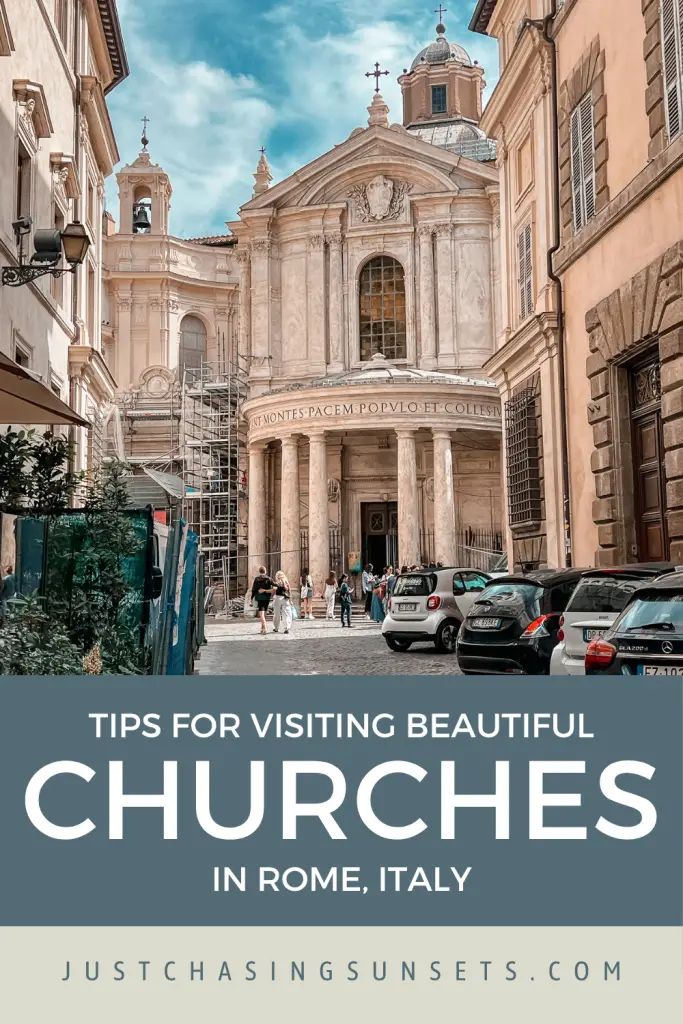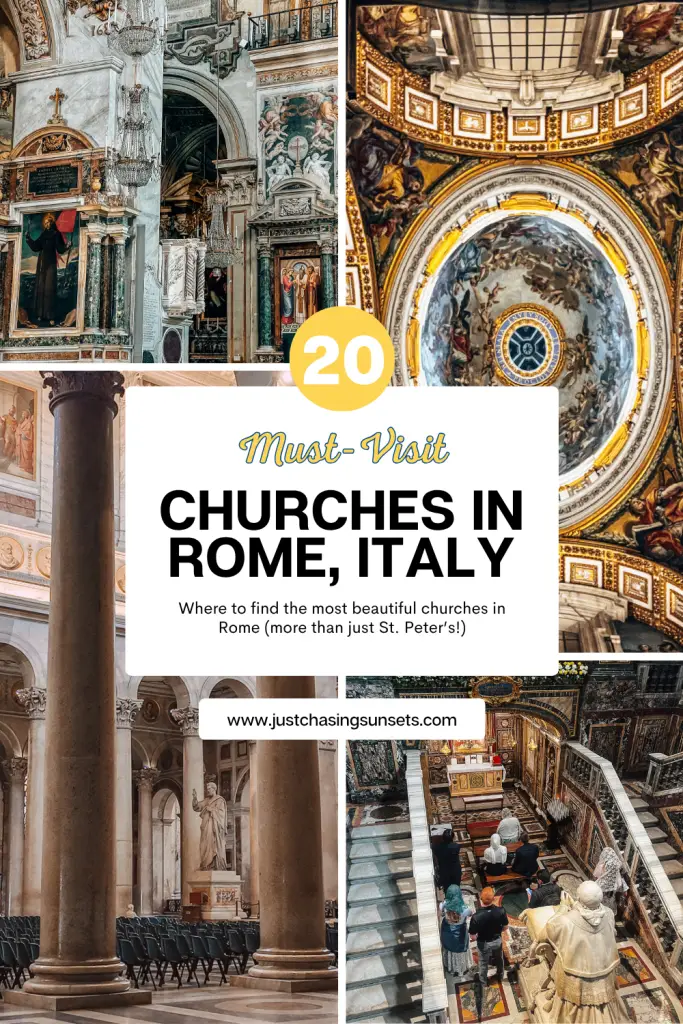Blog, Destinations, Europe, Italy
The Top 20 Most Famous Churches in Rome, Italy
Last updated on July 16th, 2025 at 07:16 pm
I never thought I’d be sitting down to write a blog post about the famous churches in Rome. Raised Catholic, as in I went to Catholic school until college, but only attended church as required by school and on Christmas and Easter, I’ve moved away from any organized religion.
Yet, my month-long immersion into Rome coincided not only with the Catholic Church’s Jubilee year, but also with the passing of Pope Francis. Just four days into my trip to Rome, the Sistine Chapel closed to visitors as the conclave began.
Two days later, as I sat in a hotel courtyard before my adult study abroad program’s welcome dinner, sipping wine, church bells rang. I got a text from my Dad – white smoke!
Ah – so that’s what those bells are for.
I considered making the 45-minute walk over to the Vatican to see who the new Pope would be, but it just seemed too far. I regretted it as other classmates showed up late to the dinner, who had opted to stand in the crowds to witness the first American-born Pope give his very first address.
Read the entire Rome travel series here:
- Rome Itinerary: How to Spend Three Perfect Days in Rome
- Rome Packing List: What to Pack for Rome in May
- Rome Neighborhoods: How to Spend a Day in Historic Monti, Rome
- Rome Travel Tips: How to Get Around in Rome, Italy
- Least Favorite Rome Activity: Tips for Visiting the Appian Way, and Actually Enjoying It
- Best Day Trips from Rome: Visiting Tivoli in a Day and Spoleto in a Day (but not the same day 😉 )
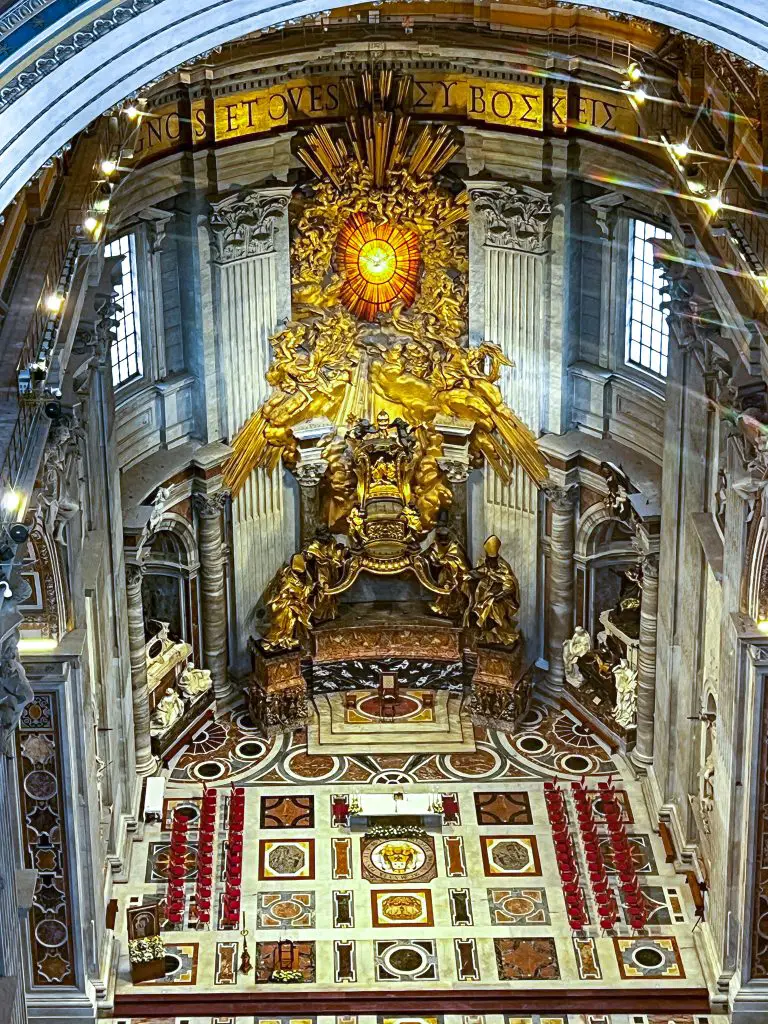

At this point, I’d already wandered into more churches than I’d been in in the last 10 years.
I didn’t realize that the next month would include more churches than I could count as my art history class church hopped to gaze upon centuries-old masterpieces.
I also didn’t realize that I’d go on my own journey of sorts, walking through all four Holy Doors open for the Jubilee year, standing in the crowds of St. Peter’s Square to listen to the first Sunday address from Pope Leo, or that I’d shed a few tears walking into one of the more popular churches on TikTok around midnight one night.
I was in a constant state of awe at the lavishly adorned and frescoed walls of the burial sites of former Popes in various churches. I grappled with the church funding such extravagant projects and burial grounds for Popes, while most people in the world have struggled throughout the centuries they were built.
Even as I struggled with my own feelings of religion and the church, I couldn’t deny the overwhelming beauty and number of churches in Rome. I also deeply appreciated that much of the great artwork and sculptures are free to access within the churches’ walls.

You can see amazing masterpieces without ever paying a dime to enter a museum.
In this post, I’ll share with you all of the famous churches in Rome I was able to visit and what to see inside them!
This post contains affiliate links, which means that, at no additional cost to you, I will earn a tiny bit of income if you decide to make a purchase or booking. For more, check out my disclosure.
Religious Symbols and Scenes
One thing I wish I’d done before going to Rome was review religious symbols and stories so that I could better understand the artwork.
I’m not ashamed to say I Googled – who was St. Peter and what was the Annunciation. Yea – I guess I blocked out those 12 years of Catholic education. Here are a few things to keep in mind to help you understand the art.
- Dove: Typically symbolizes the Holy Spirit
- Lillies: Symbolize Mary’s virginity
- St. Peter: He is typically portrayed holding keys because Jesus gave him the keys to the Kingdom of Heaven. The keys represent the power to forgive sins and open the gates to Heaven.
- St. Paul: He is typically portrayed holding a sword for a few reasons. First, because he was beheaded in Rome. Paul also references the Word of God as the sword of the Spirit. He’s also typically shown with a book, the Word of God.
- Sibyls: These were female oracles from Ancient Greece. It’s interesting how much Greek mythology and astrology make their way into Christian art.
I found it interesting that most Roman churches had different chapels off to the side, something that I was not familiar with in the churches I infrequently visited growing up.
Chapels were usually funded by wealthy families and served as their burial sites.
The artwork within the churches was also often commissioned by these wealthy families who would tell the artist what they wanted in their chapel and if they wanted to be in the artwork. This means you’ll see many scenes repeated and done in different styles by different masters. You may also see someone random in it and it’s likely the patron.
Reminder for Visiting Churches
Remember that churches require shoulders to be covered to enter. While there isn’t usually anyone there monitoring this, it is a sign of respect to dress appropriately. Make sure you add a scarf or long-sleeved button-down to your Rome packing list that you can carry with you to cover your shoulders for impromptu church visits.
The Four Major Papal Basilicas
There are four main basilicas in Rome, called Papal Basilicas, that are the most highly ranked Roman Catholic Churches. St. Peter’s Basilica, St. John Lateran Basilica, St. Mary Major, and St. Paul Outside the Walls each hold religious, historical and artistic significance.
Each of these has a Holy Door that is only open during a Jubilee Year. These Holy Doors are a specific entrance into the basilica that represents an opportunity for spiritual growth.
It only makes sense to start the journey through the city of a thousand churches through the Holy Doors of these major basilicas.
St. Peter’s Basilica
St. Peter’s Basilica, the only one of the four Papal Basilicas located within the walls of the Vatican City, is perhaps the most visited church in the world.
It was built in the 4th century by Emperor Constantine on the burial site of St. Peter. The current Papal Altar is located directly above the Saint’s tomb. In the 1500s, Pope Julius demolished the original church and rebuilt it with the help of Bramante, Raphael, and Michelangelo.

You could, and perhaps should, spend hours in St. Peter’s Basilica admiring the artwork, the baroque altar, and visiting the tombs of former Popes. It likely deserves its own blog post, but I’d just like to highlight a few of the aspects of the Basilica.
Its dome, designed by Michelangelo, is the tallest basilica dome in the world and it dominates Rome’s skyline.


If you’d like, you can climb to the top for stunning views of St. Peter’s Square, Vatican City and Rome. To do this, just know that it requires an elevator ride to skip to the first 200 steps, but then you need to climb the remaining 300 steps. The passageways are very narrow and if you struggle with claustrophobia could pose a problem, especially when it’s crowded.
If you reach the top of the dome, you can see the idea behind the creation of St. Peter’s Square by Bernini. In the center of the square is an Egyptian obelisk but the sides reach out from the Basilica almost as if they’re arms gathering together and welcoming those in the square. It then extends out into the rest of Rome.
Book your ticket to climb St. Peter’s Dome and get a guided tour of the Basilica.
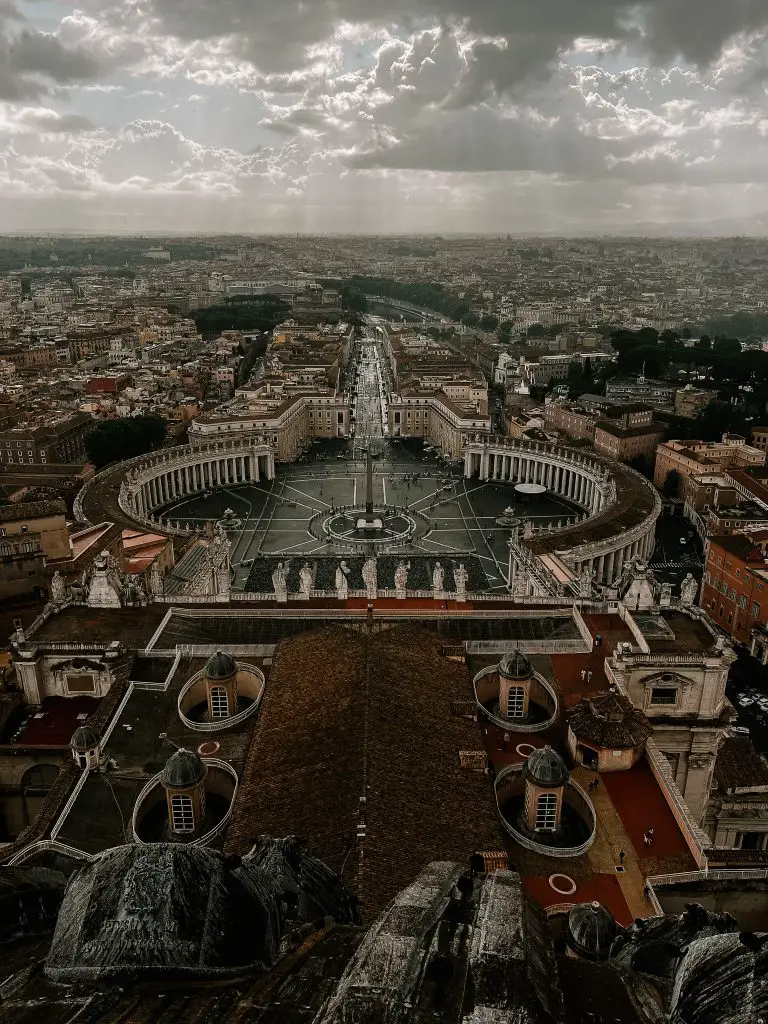
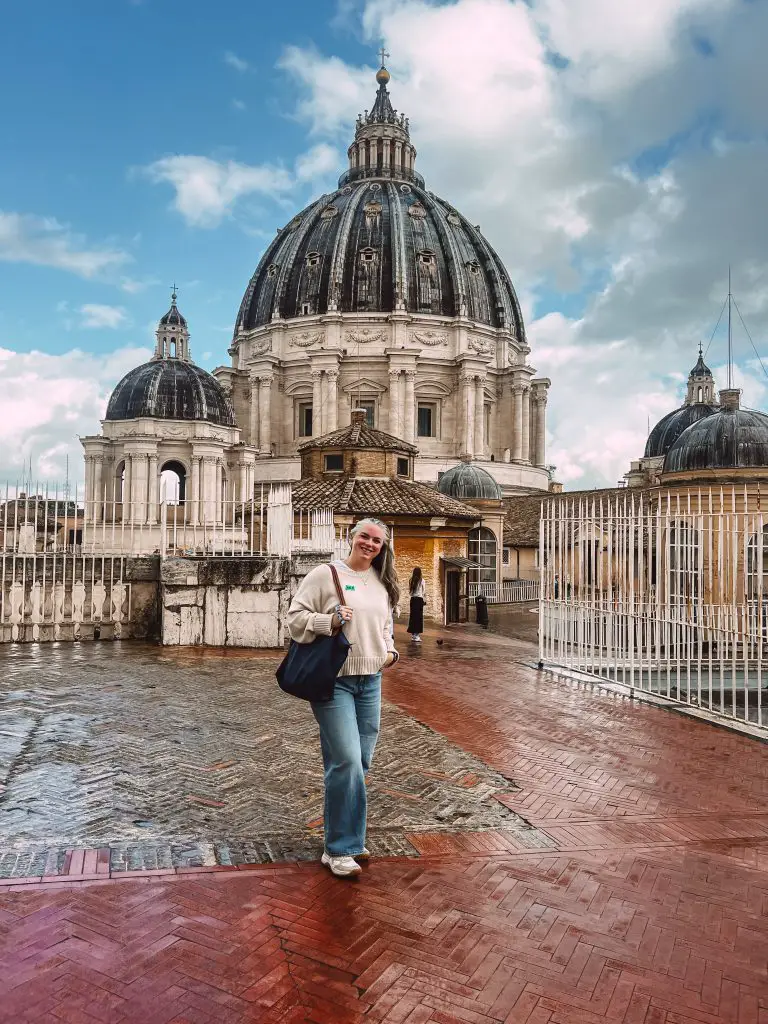
Back on the ground, entering through the Holy Door, you’ll see La Pietà sculpture by Michelangelo. This moving piece depicts the Virgin Mary cradling Jesus’ dead body after his crucifixion. Whether you’re religious or not, it’s an incredibly emotional piece that beautifully depicts grief and compassion.
It’s amazing to see how Michelangelo was able to use a hammer and chisel to create such a soft sculpture from Carrara marble.


Basilica of St. Paul Outside the Walls (Basilica Papale di San Paolo Fuori le Mela)
About 3 miles (5km) away from St. Peter’s Basilica is St. Paul Outside the Walls. The second largest basilica to St. Peter’s, St. Paul’s was founded in the 4th century, also by Emperor Constantine. It was built on the location of St. Paul’s death and burial. You can see his tomb under the High Altar in the Basilica.
The grand atrium of the Basilica has 150 columns surrounding a statue of St. Paul. On the building’s exterior is a beautiful medieval mosaic with a gold background that reflects the sun.
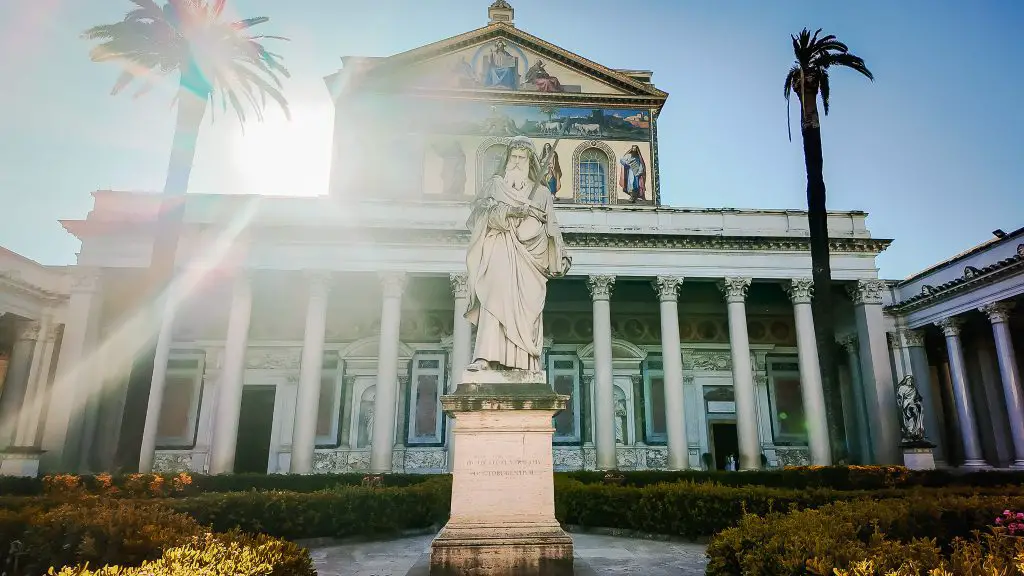
Much of the vast interior that you’ll see as you enter the Holy Door was done in the 19th century after a fire ruined most of the original artwork.
At the top of the walls 265 large medallions depict every single Pope (with room for 8 more).
While the basilica is a bit far from Rome’s city center, it’s well worth a visit – the atrium was my favorite part!

Book a guided tour of St. Paul Outside the Walls so you don’t miss anything!
Basilica of St. John Lateran (Arcibasilica di San Giovanni in Laterano)
If you thought St. Peter’s Basilica was the most important church in Rome, you’d be wrong… like me.
It’s actually Archbasilica di San Giovanni in Laterano, the oldest church in Rome. This was the original papal seat and is still considered the Cathedral of Rome. All popes were crowned here until 1870 and the Pope still says Holy Thursday mass here.
While I entered through the Holy Door, the main church doors are from the Senate House in the Roman Forum.
As you enter, notice the beautiful mosaics on the floor and in the apse. Parts of these mosaics survived from the 4th century, but many were restored in the 18th century by Borromini.


Across the street from the Basilica is Scala Santa, or the Holy Steps. These steps are believed to be the 28 steps that Jesus climbed to his trial before Pontius Pilate. Emperor Constantine’s mom, St. Helena is said to have brought them to Rome.
Many people climb the steps on their knees as an act of pilgrimage. At the top of the stairs is the Sancta Sanctorum, the private chapel of the Pope.
It is believed that pieces of the cross, wood from the Last Supper table, and perhaps even Jesus’ foreskin are in the Sancta Sanctorum.
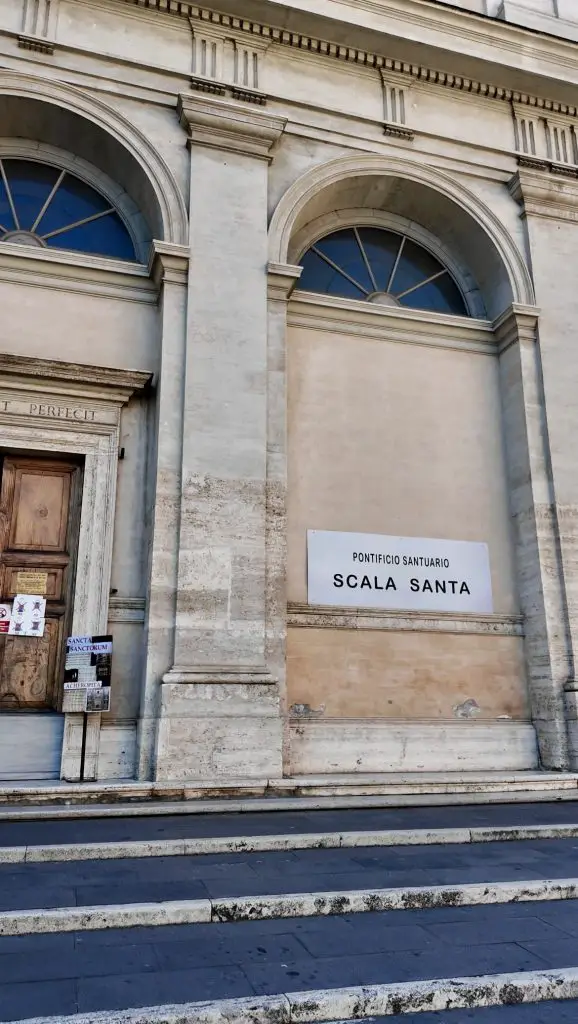

If you’d like to visit the Sancta Sanctorum without climbing on your knees, there are two marble staircases on either side that you can walk up normally.
There were only a handful of people making the climb when I visited. I opted not to make the climb or visit the chapel as it was barely 9:00 am and already 80 degrees!
Book a guided tour of St. John Lateran so you don’t miss anything!
Basilica of St. Mary Major (Basilica Papale di Santa Maria Maggiore)
St. Mary Major was actually the first of the four Papal Basilicas I visited in Rome. I went early one morning before class as it was near my neighborhood, Monti, and I wanted to see the burial place of the recently passed Pope Francis.
As the name suggests, the Basilica is devoted to the Virgin Mary. Legend has it that Mary appeared to Pope Liberius and the Patrician John in 352 and told them to build a church on a spot where snow had fallen… in the middle of the summer.
The legend continues that snow fell on the night of August 4th on the top of Esquiline Hill, one of Rome’s seven hills. No trace of the 4th-century church remains.

The current basilica, however, dates back to the 5th century and is the oldest Marian church.
Pope Francis would visit this church before and after his Apostolic Journeys to pray to the Virgin Mary via the important Salus Populi Romani icon. As such, it makes sense that he is buried here.
I entered through the Holy Door to the left of the main doors which is the same side of the Basilica where Pope Francis is buried. It is a very simple, all white tomb with only a silver cross on the wall. On the floor is a white platform with the name Francis engraved in silver across the top.
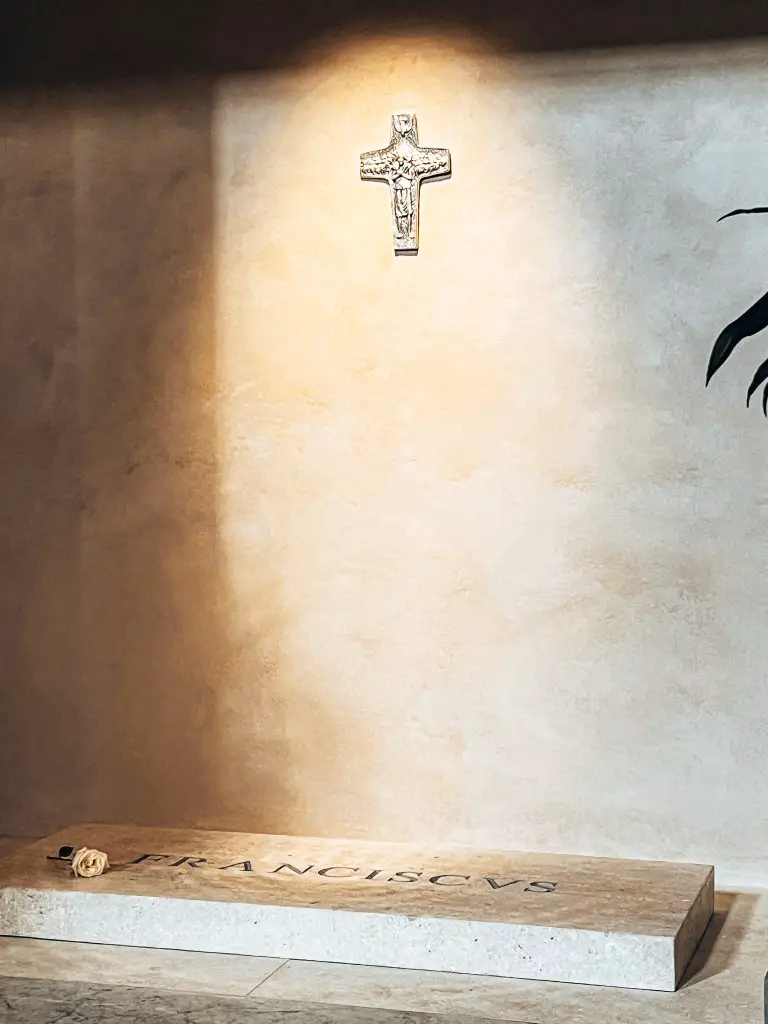

Also of importance in the Basilica are relics of Jesus’ crib. Pieces of wood from Jesus’ crib are protected inside a crystal and silver reliquary under the High Altar.
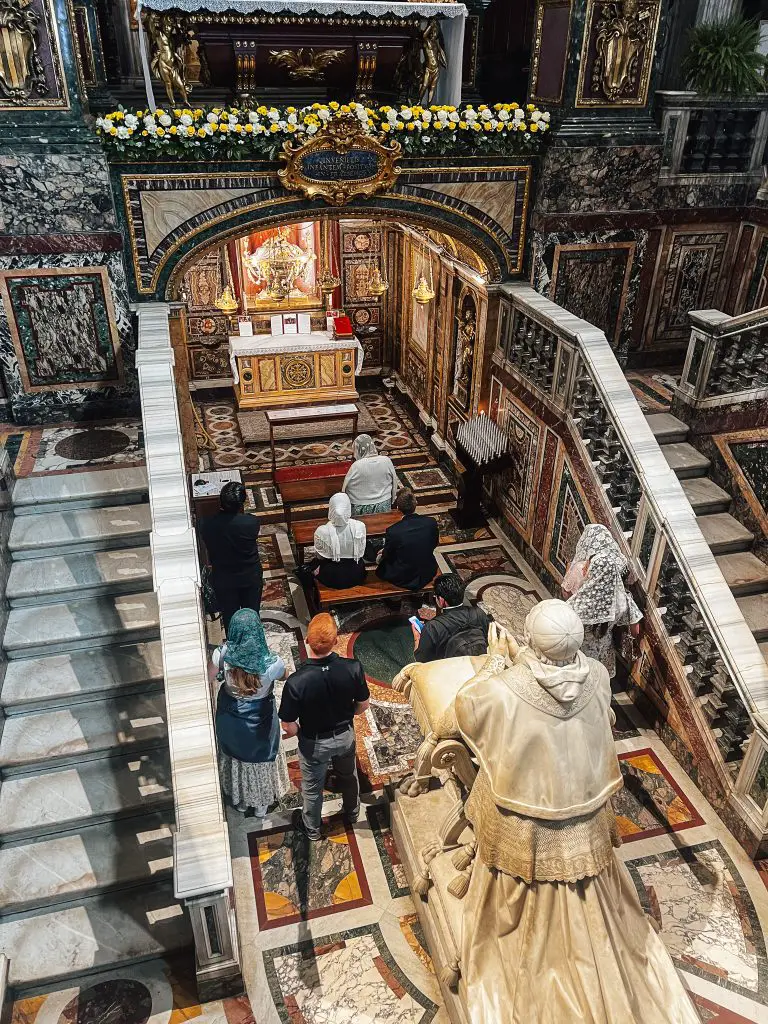
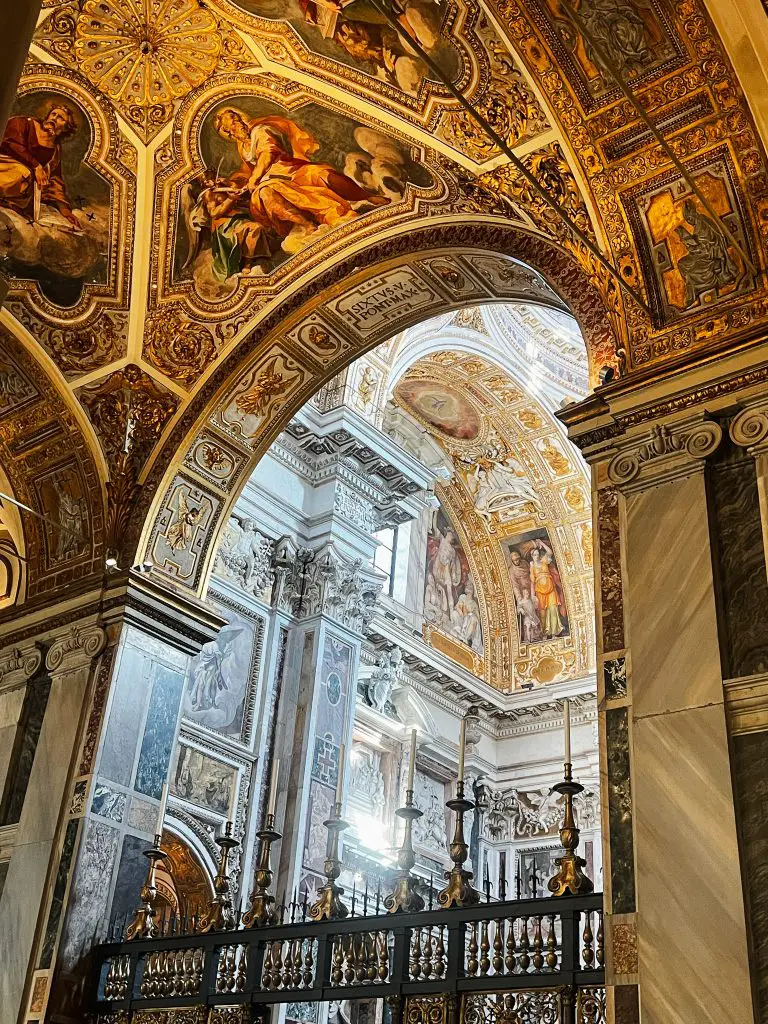
That’s a wrap on the four Papal Basilicas of the Catholic Church. Now let’s get into the other amazing churches you should visit during your time in Rome.
I recommend going early in the morning to beat the crowds or purchase this skip-the-line ticket.
Book this guided tour to three of the four Papal Basilicas!
Minor Basilicas of Rome
In addition to the four major basilicas, there are many minor basilicas that hold religious significance.
Basilica of San Pietro in Vincoli
Just a 10-minute walk from St. Mary Major is San Pietro in Vincoli or St. Peter in Chains.
This Basilica was built in the 5th century to house the chains that bound St. Peter in Jerusalem. Legend has it that the chains from Jerusalem were given as a gift to Pope Leo I. When he held them next to another set of chains that bound St. Peter when he was in Rome’s Mamertine prison, they supposedly fused together. Both pairs of chains are held underneath the High Altar.

However, I was there to see Moses, a stunning sculpture for the tomb of Pope Julius II, done by Michelangelo in the 1500s. The tomb is unfinished as while Michelangelo worked on it, Pope Julius II had him stop to paint the Sistine Chapel.
Can you imagine being able to both sculpt masterpieces out of marble and then turn around the next day to paint one of the most impressive ceilings in the world?
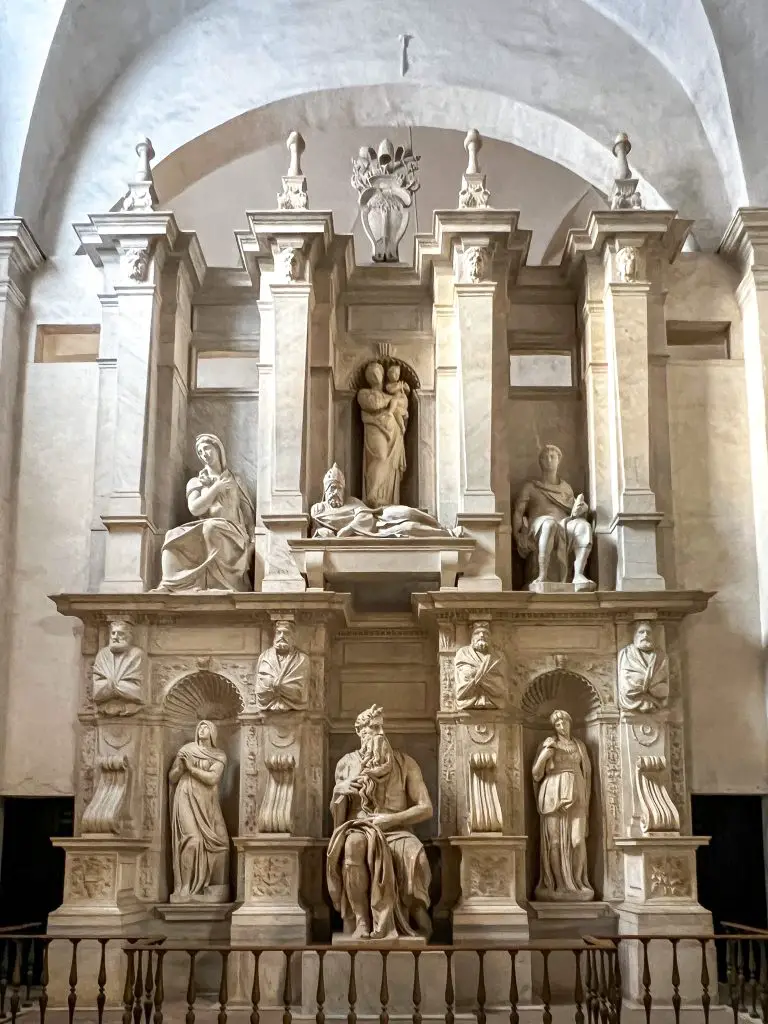

Back to Moses – as with many things, pictures don’t do justice to the imposing 8ft tall (sitting down) figure. There is such energy in the sculpture it almost looks as if he is going to stand up from the chair. His beard also appears as if it’s flowing!
St. Peter in Chains is a must-visit and easy to combine with other nearby churches and tourist sites in Rome, like the Colosseum.
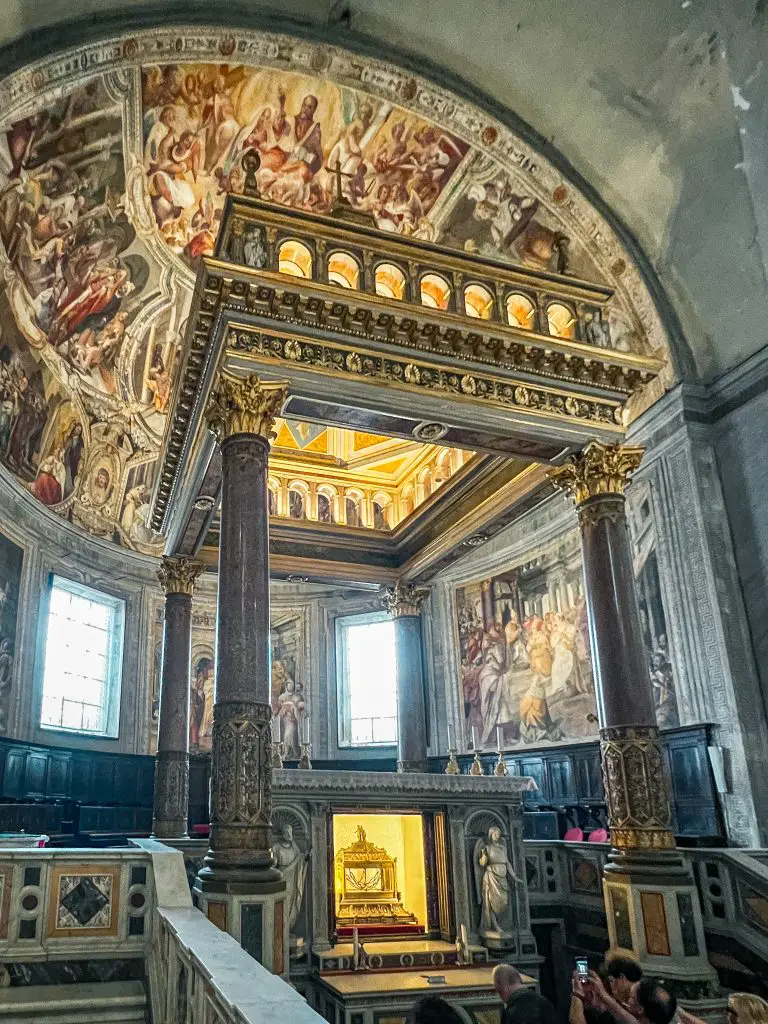
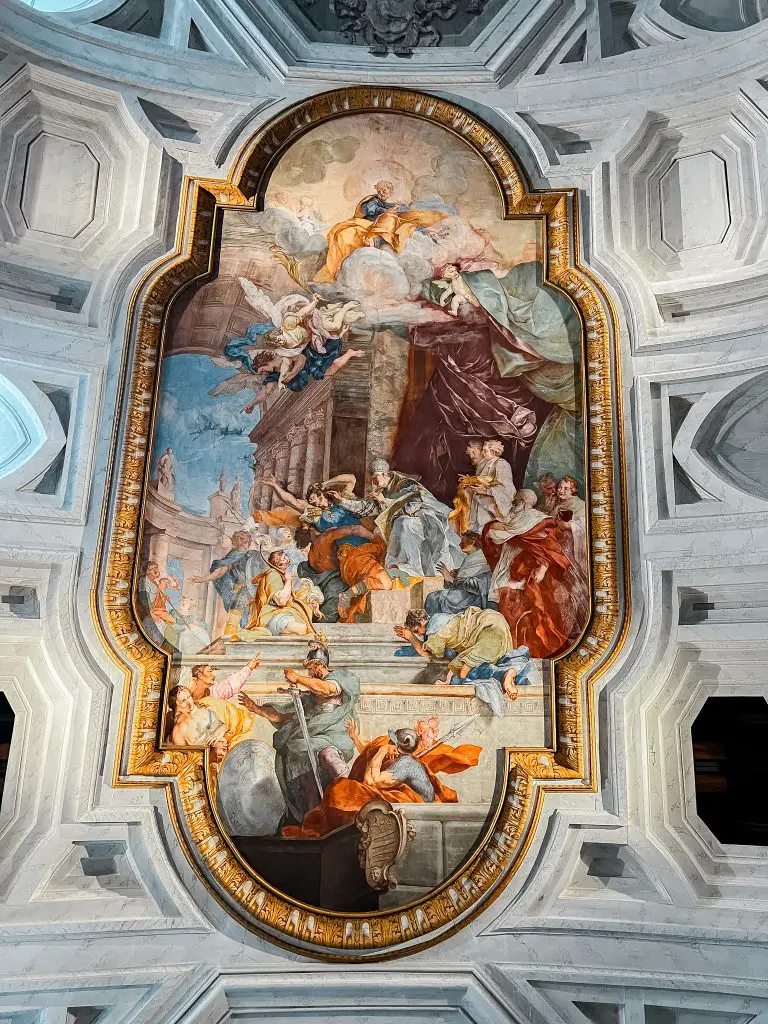
Santa Maria in Aracoeli Basilica
Santa Maria in Aracoeli stands on the highest point of the Capitoline Hill and, as such, has an amazing view from the main entrance.
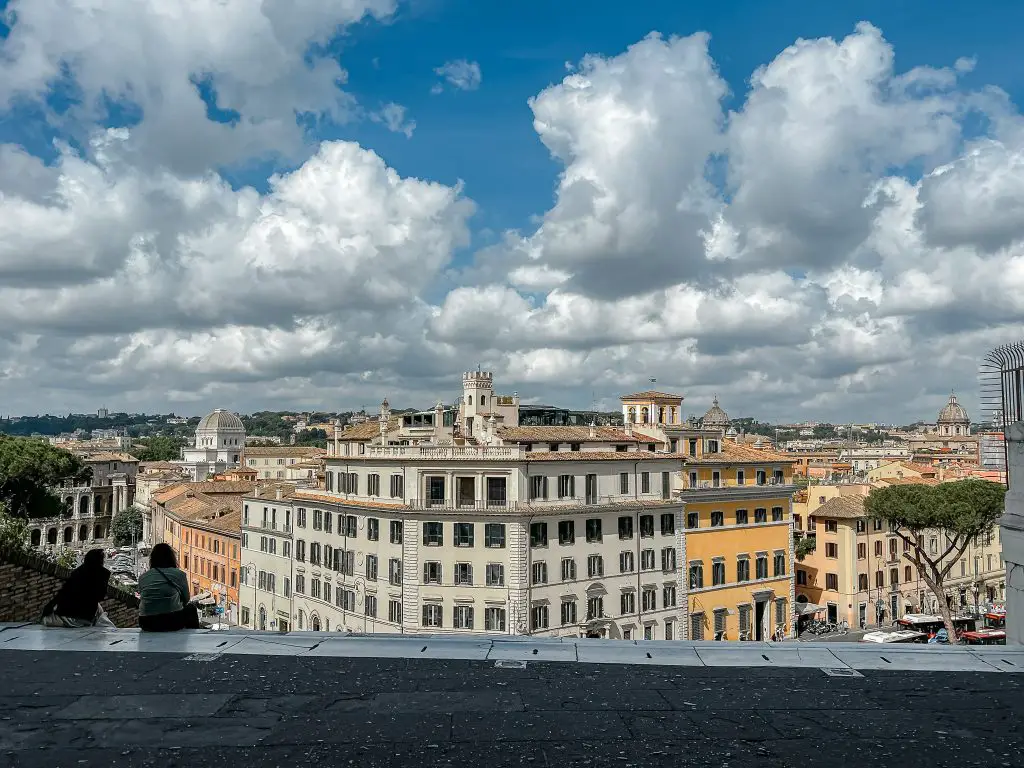
To avoid climbing the steep 124-step staircase to enter, walk the stairs to the Capitoline Museum instead, then walk around the back, to the left. You’ll see another set of stairs and a small teal door. Enter through there.
That being said, the staircase is also considered a Scala Santa as it was built for the Virgin Mary to end the plague. Mothers, those wishing to be mothers, and spinsters wanting a husband would climb the stairs on their knees.


Aside from the stunning view, there is a beautiful fresco by Pintrucchio in the Bufalini Chapel that depicts the life of St. Bernardino of Siena, a Franciscan Friar. On the chapel’s floor you’ll see the serpentine Cromatesque mosaic flooring. In the center is the coronation of St. Bernardino and the vault depicts four Evangelists.
On the right wall are scenes from St. Francis of Assisi’s life and on the left wall depicts the funeral of St. Bernardino.

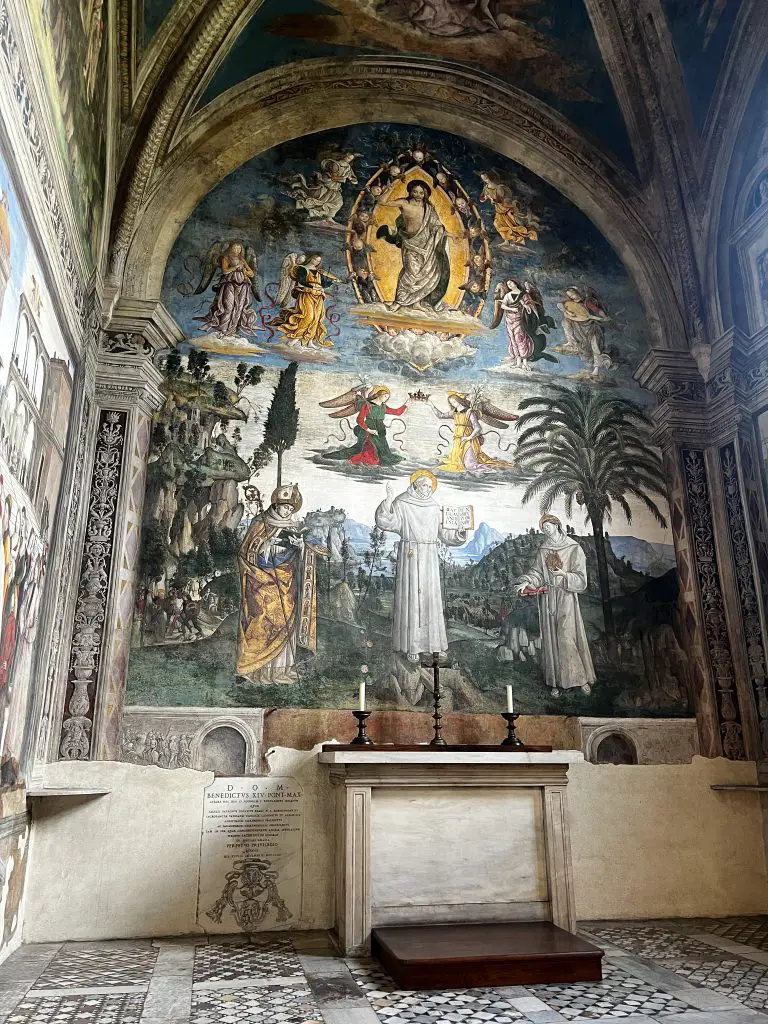
Basilica of Santa Maria Sopre Minerva
Just a few steps from the Pantheon is the Basilica of Santa Maria Sopre Minerva, the only Gothic church in Rome, built in 1200 BC by the Dominican order.
It was built on the ruins of an ancient temple dedicated to the goddess Isis.
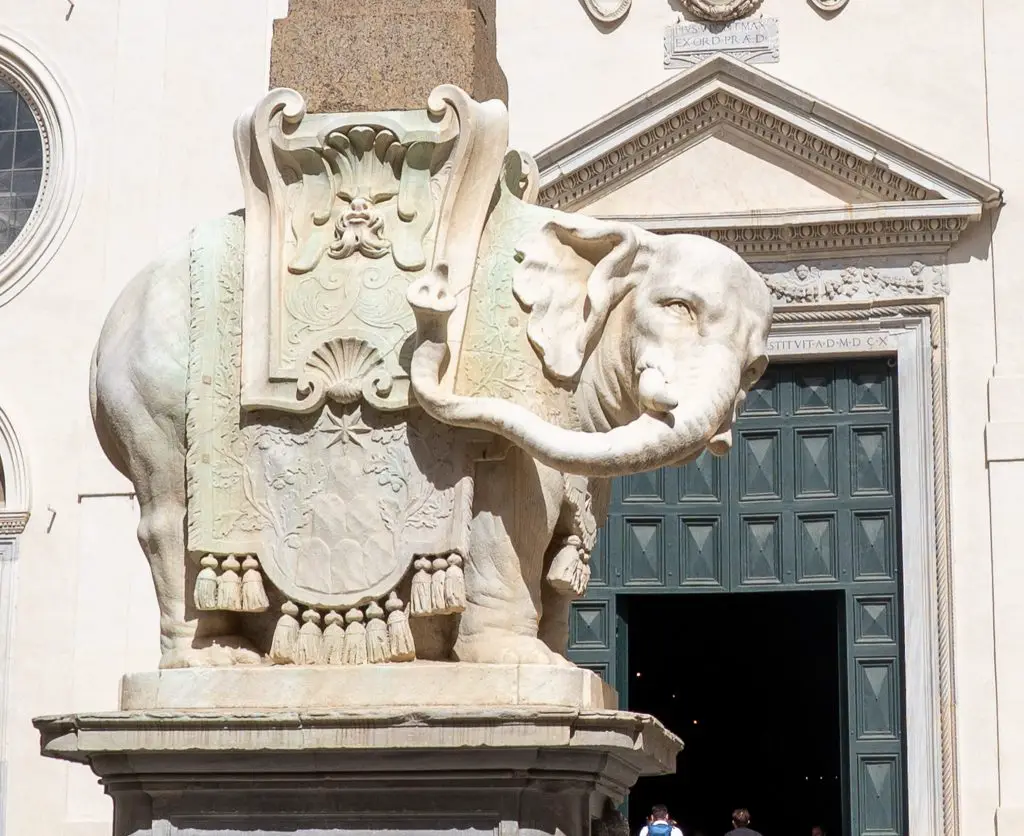
Outside of the Basilica is an Egyptian obelisk with hieroglyphs that dates back to 6 BC. It was placed on the back of a whimsical elephant created by Bernini.
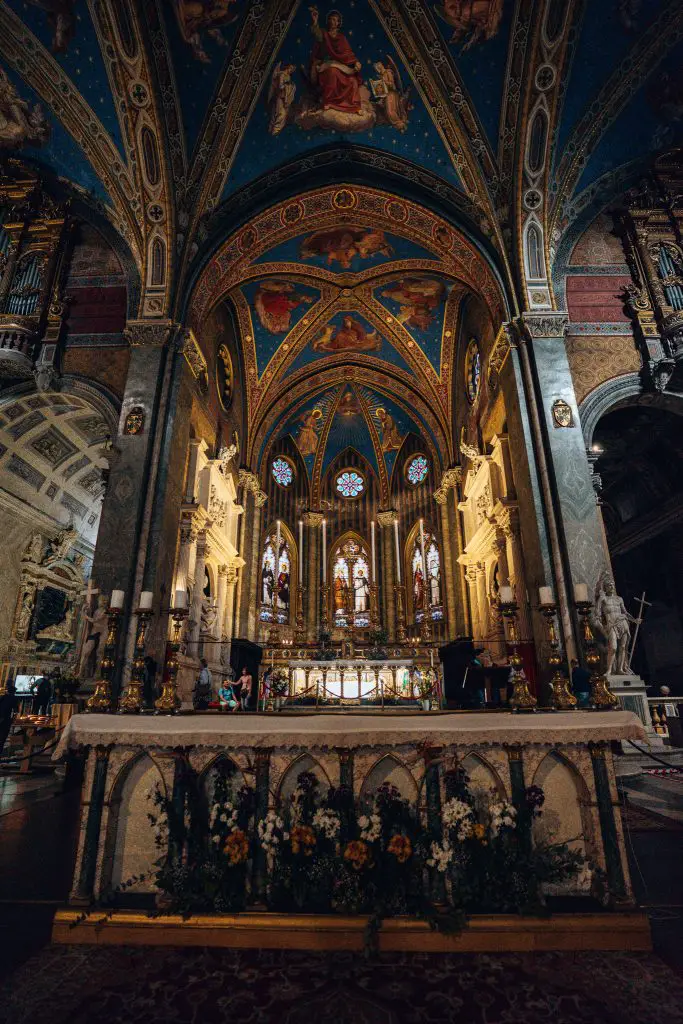
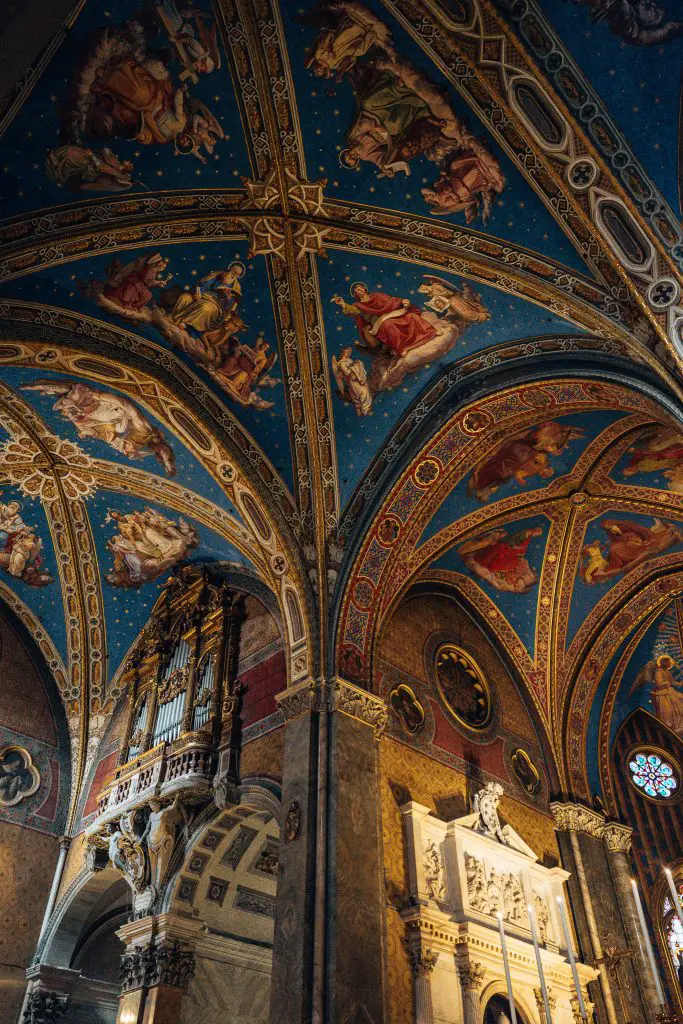
Inside, the stunning blue ceilings lead you to the High Altar, under which is the marble tomb of St. Catherine of Siena. The tomb contains most of her skeleton, while her head is in a church in Siena.
To the right of the High Altar is the Carafa Chapel dedicated to St. Thomas Aquinas. The chapel is adorned with stunning frescoes by Filippino Lippi. Behind the chapel’s altar is the Annunciation scene where the Angel Gabriel appears to the Virgin Mary as she is blessing Cardinal Carafa who is presented to her by St. Thomas Aquinas.
The right wall depicts scenes from St. Thomas Aquinas’ life and the ceiling depicts four of the sibyls.


Basilica Parrocchiale Santa Maria del Popolo
On the hunt for Caravaggio paintings? Head to the Basilica of Santa Maria del Popolo. Located in Piazza del Popolo, this Basilica is not one of the two churches that dominate the plaza. Instead, this unassuming Basilica is off to the side near the arched Porta del Popolo gateway.
Near the altar, to the left, in the Cerasi Chapel are two Caravaggio paintings, the Crucifixion of St. Peter and the Conversion of St. Paul on the Way to Damascus.
Per usual, my photos don’t do these masterpieces justice. I preferred viewing them without the light as the darkness of the paintings allows you to slowly take in the image. But other visitors kept paying to illuminate them. To each his own!
Basilica di Santa Maria in Trastevere
Located in the charming Trastevere neighborhood is the Basilica di Santa Maria in Trastevere. This Basilica, dedicated to the Virgin Mary, is considered the oldest Christian Church as it was a gathering space for 3rd-century Christians before Emperor Constantine converted to the faith.
A fun fact our professor told us about this church is the Fons Olei legend. This legend holds that before Jesus’ birth, olive oil surged from the ground and ran out into the Tiber River for a full day. The local community believed it was a sign that Christ would come to save the pagans.


As such, it was a holy place for early Christianity.
From its inception, it saw the rise and fall of the Roman Empire, Norman invasions, and more. It was rebuilt in the 12th century by Pope Innocent II using columns from Egypt and the Baths of Caracalla.
On the facade is a 12th-century Byzantine mosaic made of glass chips. Mary is the main character as she dwarfs the popes that surround her.
Inside the church, the mosaics of the apse, done by Pietro Cavallini, depict Mary’s life and summarize the Christian faith.

Basilica di Santa Cecilia in Trastevere
The Basilica di Santa Cecilia en Trastevere is dedicated to the patron saint of music, St. Cecilia. Her home was where the church now stands. In her home, she was tortured for three days for trying to convert her family in 230 AD.
Many years later, in the 1500s, they found the Saint in her tomb, her body completely intact with wounds on her neck (she was beheaded). Under the altar is a marble statue of St. Cecilia in the position she was found.


Basilica of Saint Augustine (Basilica of Sant’ Agostino)
Just a few minutes walk from Piazza Navona is the Basilica of Sant’ Agostino completed in the 15th century and home of the Augustinian Friars.
Inside, houses multiple pieces of art, from Raphael’s frescoes to Caravaggio’s dark naturalism and the famous Madonna del Parto sculpture.
As you enter the church, to the left is the Madonna del Parto, or the Madonna of childbirth. This sculpture is a popular site of prayer for pregnant women and those wishing to become pregnant. On the wall next to it, you’ll see photos of babies born after the mother prayed to the statue.
As you continue into the church, you’ll see a Caravaggio painting, Madonna of the Pilgrims. In this painting, Mary opens her door while holding baby Jesus to a poor man and woman. In true Caravaggio style, it depicts the world as it is, dirty feet and all. There is also only the hint of a halo around Mary’s head, which makes you believe that this could be any woman.
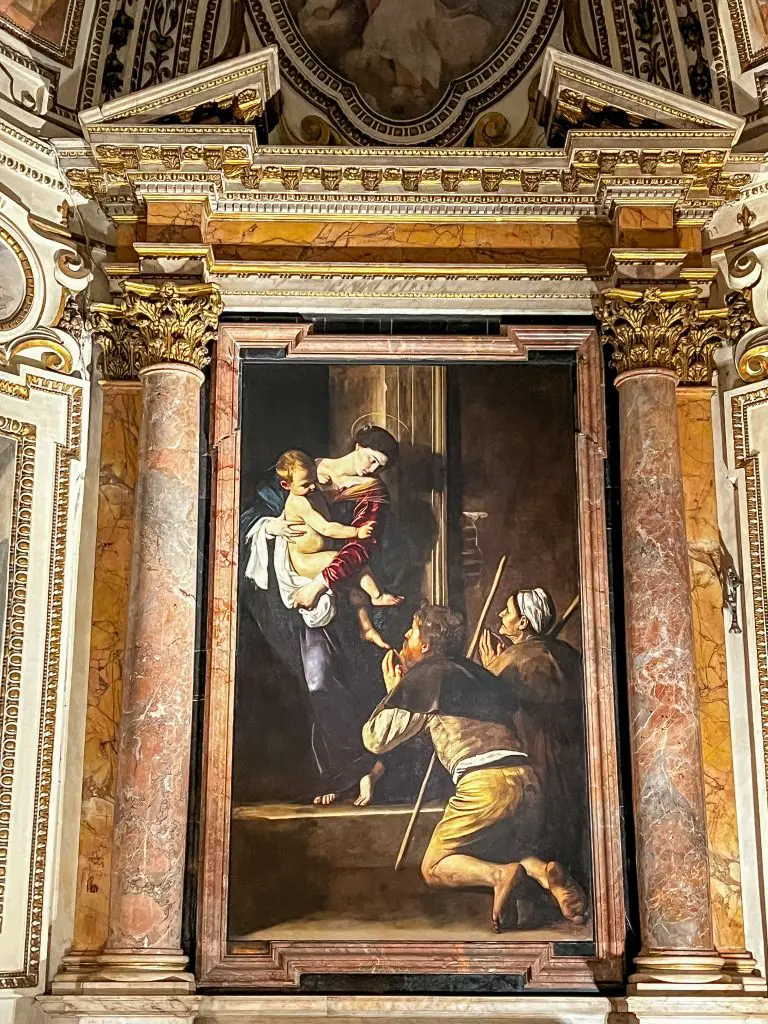

Another important piece of art is from Raphael, who is buried in the Pantheon nearby.
On the third pillar to the left is Raphael’s powerful fresco of the prophet Isaiah. It shows the prophet flanked by two angels, holding a scroll with Hebrew writing about the entry to heaven. The fresco is located above the sculpture of the Madonna and Child with St. Anne. Mary holds baby Jesus as St. Anne, Jesus’ grandmother, appears to tickle his foot, making the Holy Family appear more human and approachable.

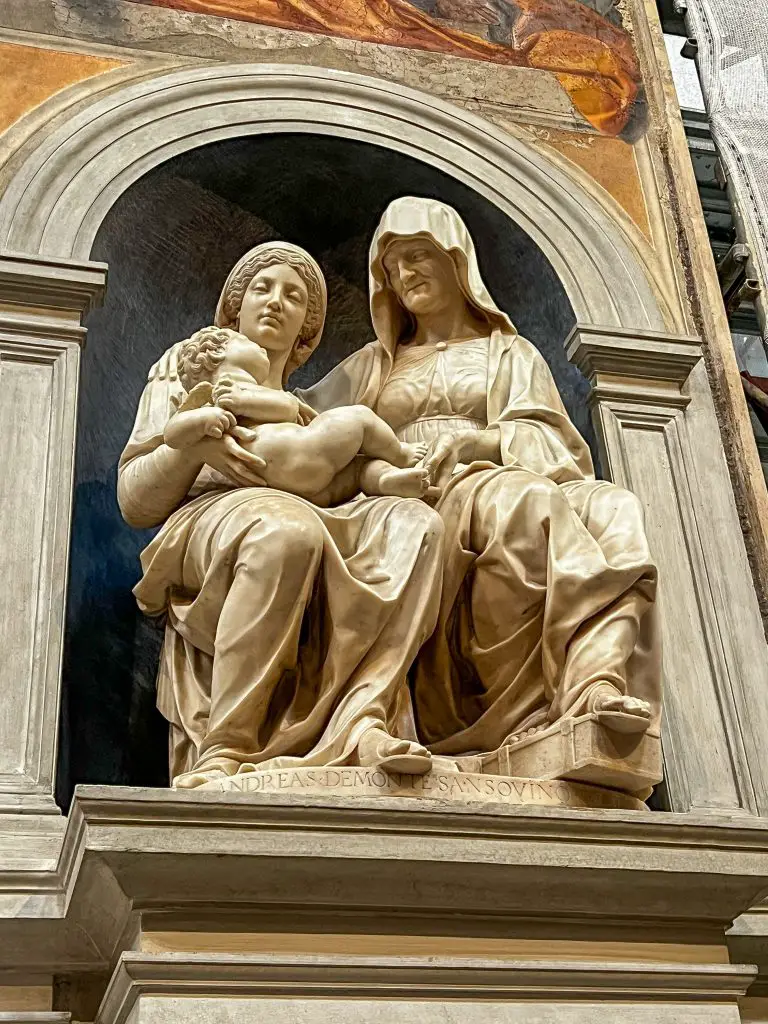
Other Must-Visit Churches in Rome
While not major or minor basilicas, these churches in Rome have beautiful art and architecture that make them worth a visit.
Chiesa di Santa Maria della Pace
Somewhat hidden away near Piazza Navona is the beautiful Church of Santa Maria della Pace.
A church has stood there since ancient times but was rebuilt in the 1500s after a period of massive instability and war as a way for the church to say sorry.
I loved the beautiful curved entrance, but inside was equally beautiful.


Inside, stop by the first chapel on the right where you’ll see a fresco by Raphael that shows the 4 sibyls that tell the future. Raphael expertly depicts the sibyls as animated as they receive messages from angels and the prophecy of Jesus’ birth.
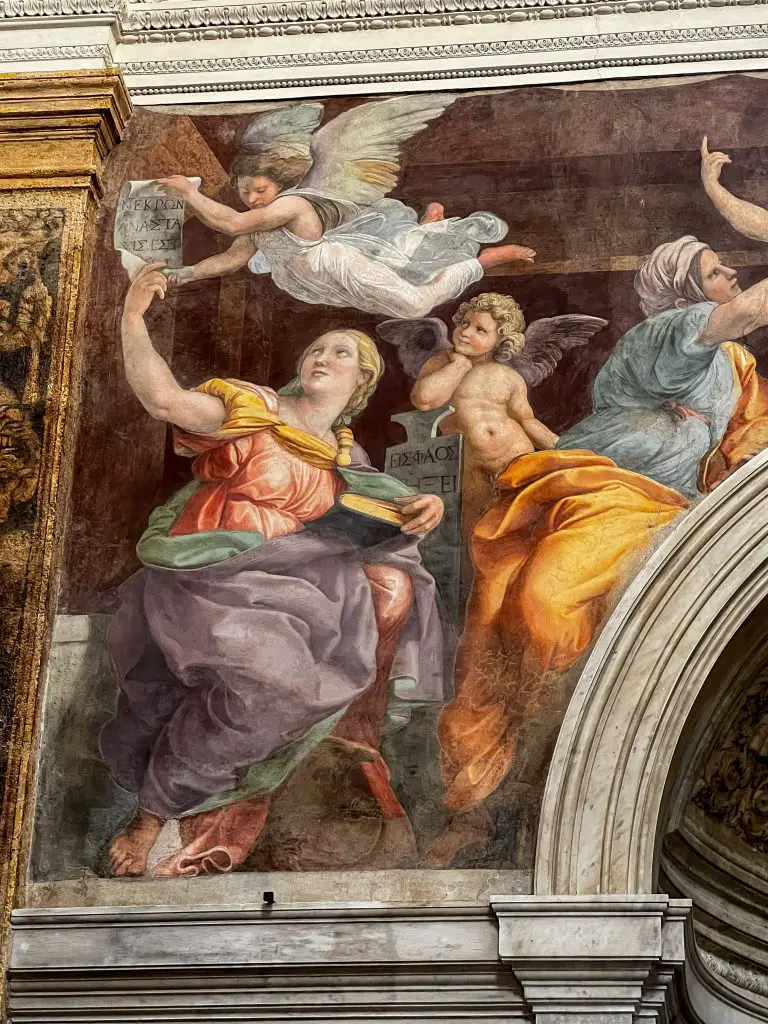
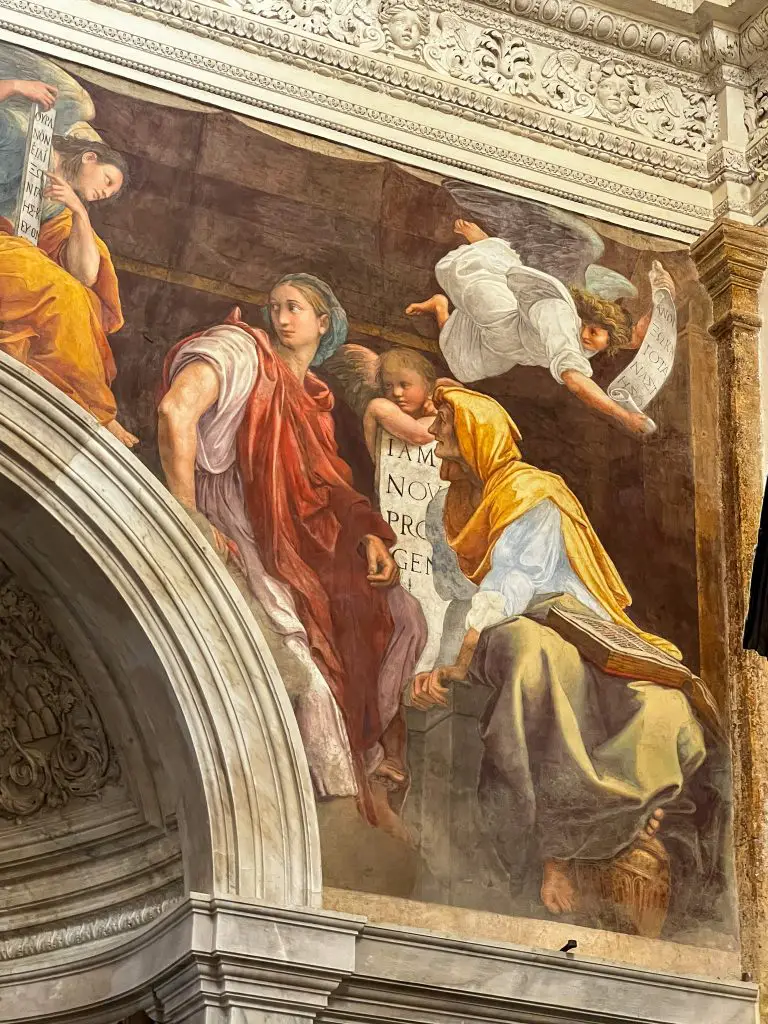
Chiesa di San Benedetto in Piscinula
Hidden away in Trastevere is the small Church of San Benedetto. Inside is a beautiful example of Cosmatesque floor, the original floor from the 12th century.
Off to the left is the Chapel of the Virgin and off of that is this tiny room called the cell of St. Benedict which is supposedly where he slept.
This small church is a quick stop while you’re wandering around the winding streets of Trastevere.
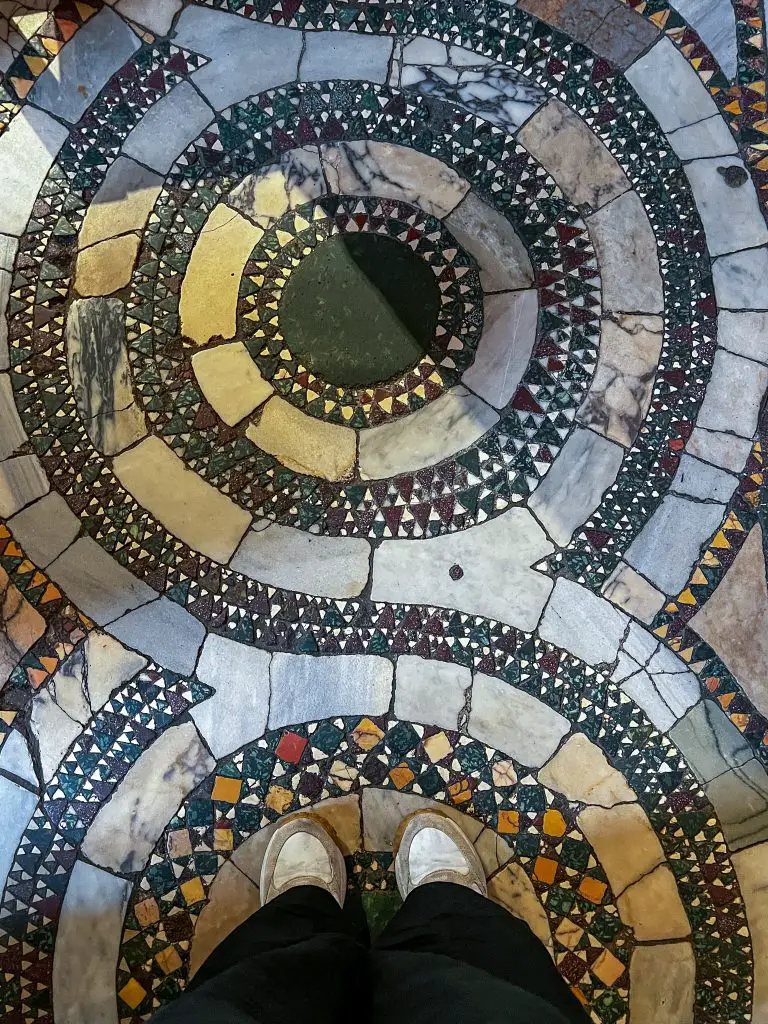
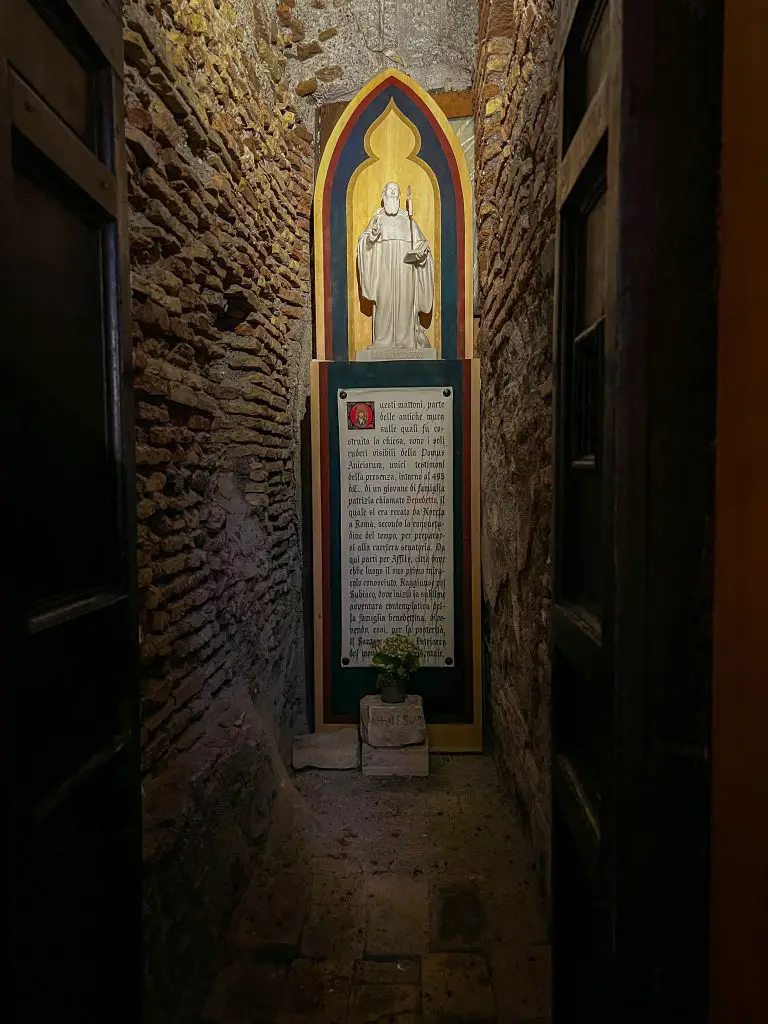
Chiesa di Sant’Ignazio di Loyola
You’ve probably seen Chiesa di Sant’Ignazio on your TikTok for you page. It’s famous for the stunning frescoes on the ceiling by Andrew Pozzo. He plays with perspective so it looks like the artwork is infinite. Even the dome isn’t actually a dome; it’s a flat ceiling that he paints to look like a dome.
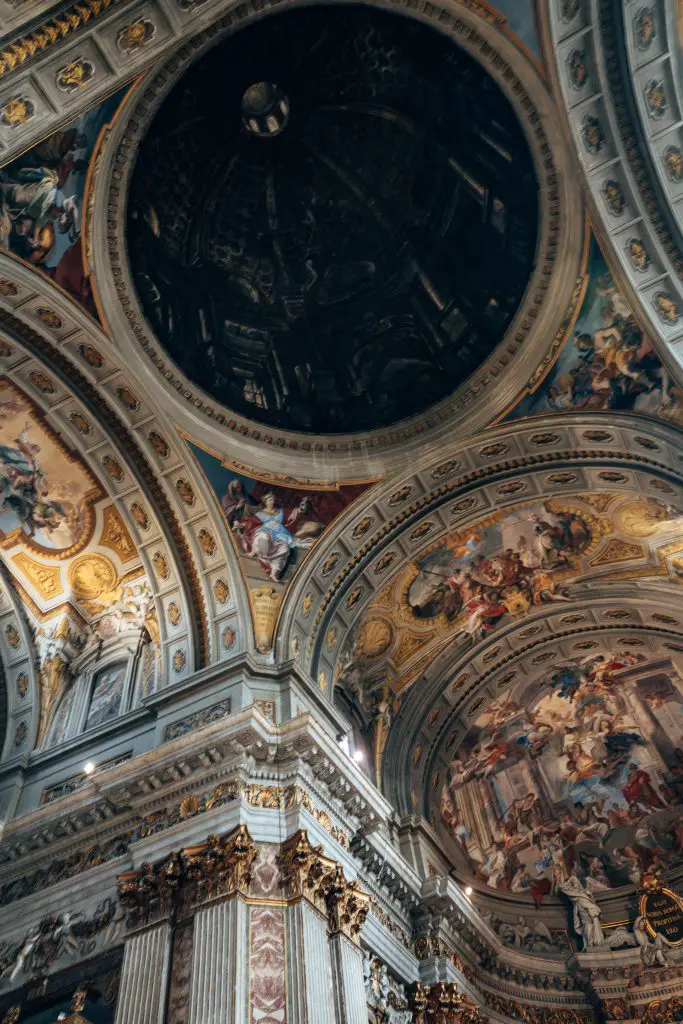
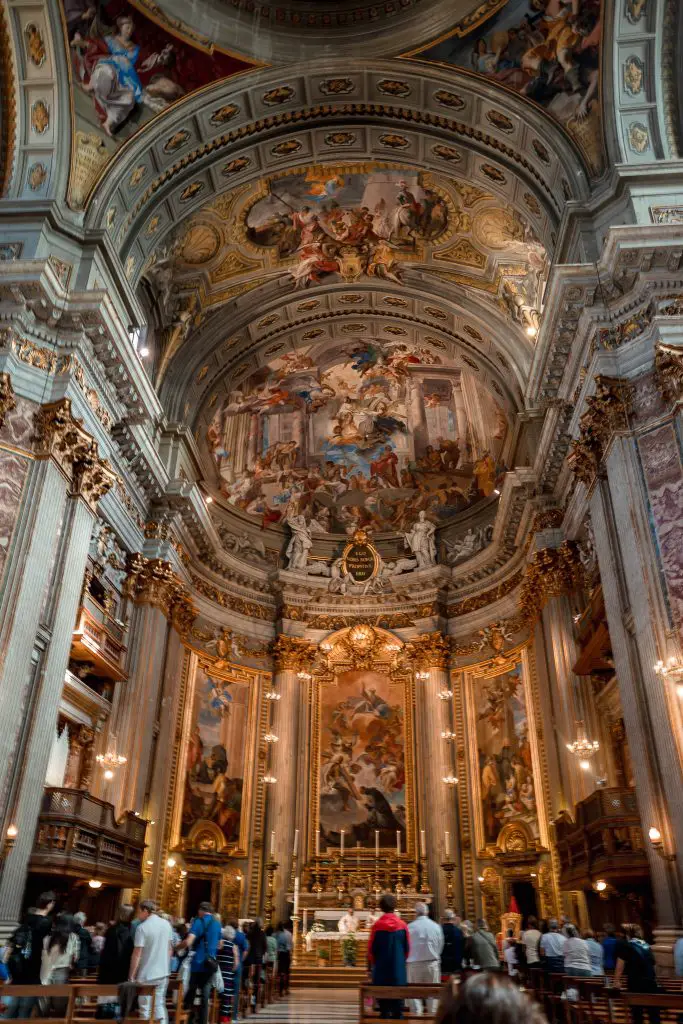
There is a selfie mirror that people line up to use. The first time I visited the church was in the middle of the day and the line wrapped through and outside the church down the street for the mirror.
But I happened to pass it later in my trip, around midnight. I was surprised to find the church open and no one waiting to use the mirror. Aside from not having to wait in line, it was a special experience to be in the church after dark. I highly recommend it.
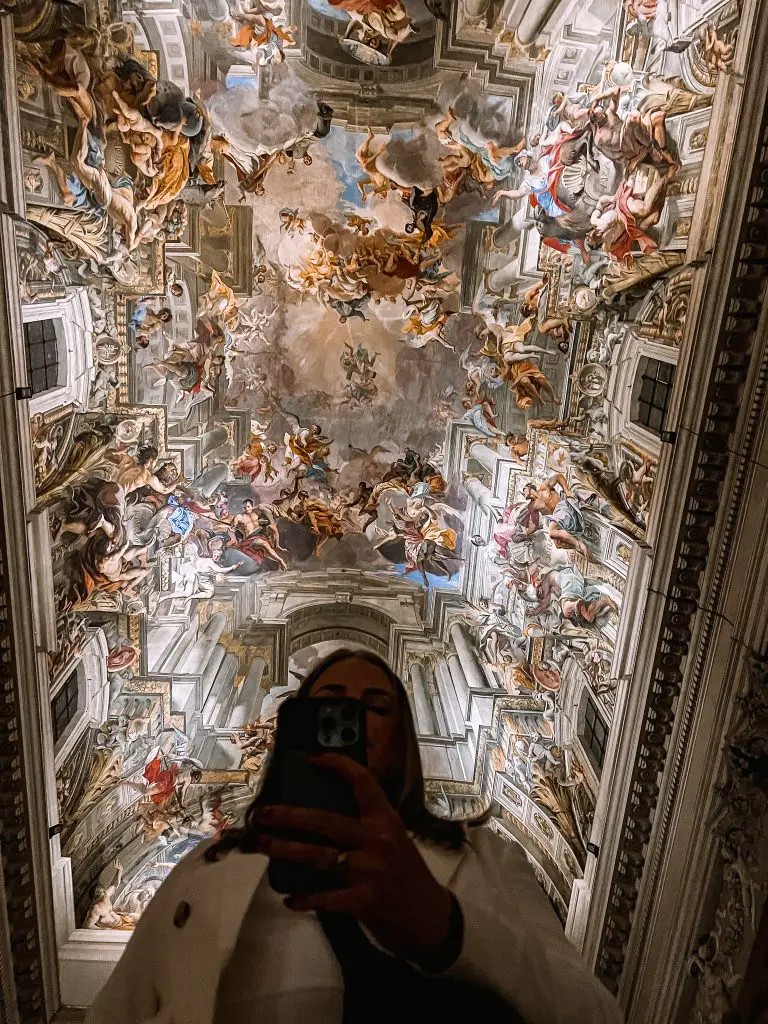
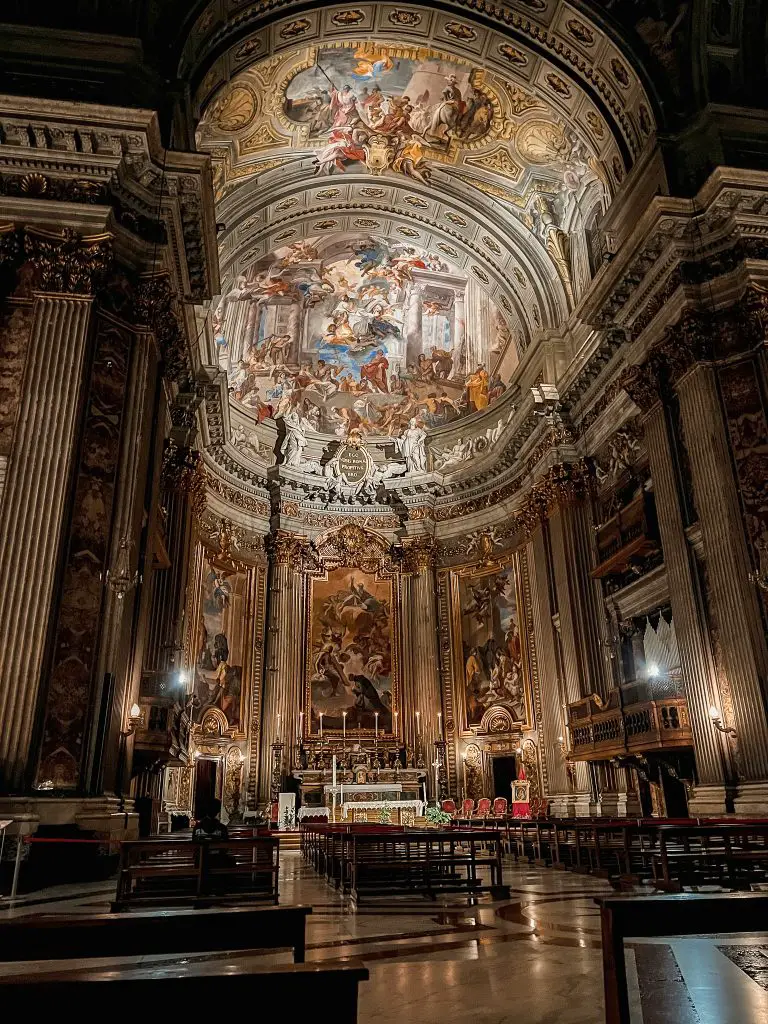
Santa Maria della Vittoria
Inside the baroque walls of Santa Maria della Vittoria is the stunning statue of The Ecstasy of St. Teresa of Avila by Bernini.
The sculpture depicts the day that St. Teresa had a vision of an angel plunging a golden arrow into her causing immense joy as well as pain. It depicts her spiritual transformation through the Word of God.
This sculpture is illuminated by gold rays coming down, and a hidden window above it that if you time it right, adds to the beauty of the piece.


Church of San Carlo alle Quattro Fontane
The Church of St. Charles of the Four Fountains is my favorite church in Rome. It was designed by Borromini for the Trinitarian Order.
Borromini built the church free of charge as a way to jumpstart his individual architectural career. He had a challenge on his hands to build the church in a very small space near Quirinale Hill.
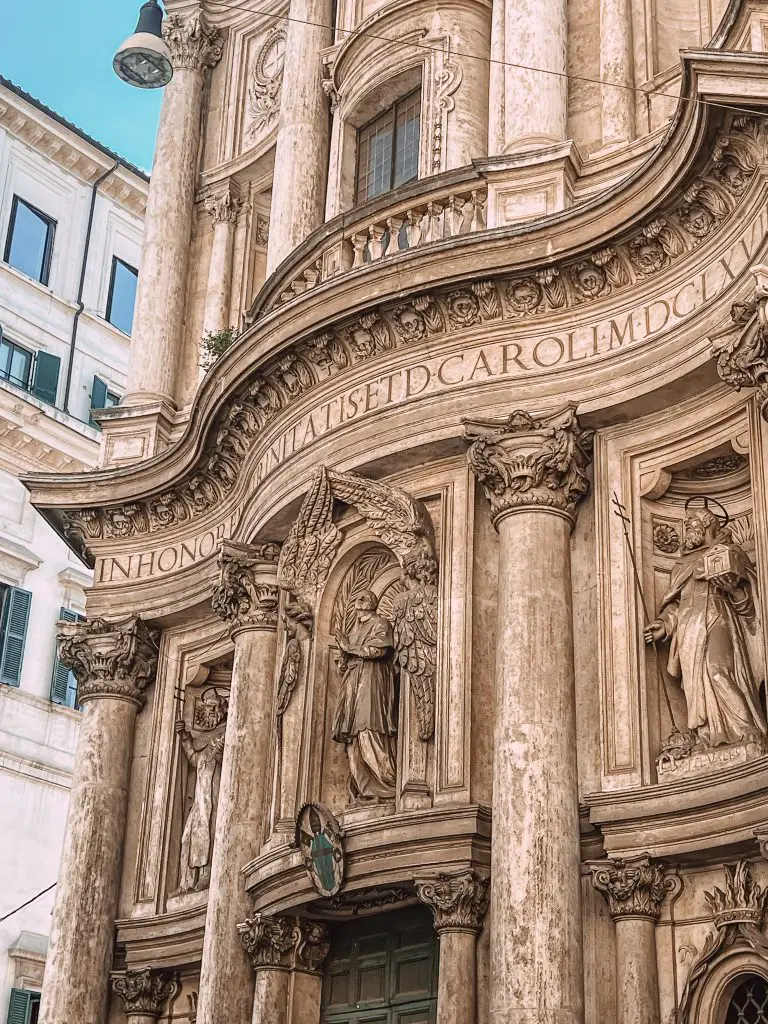
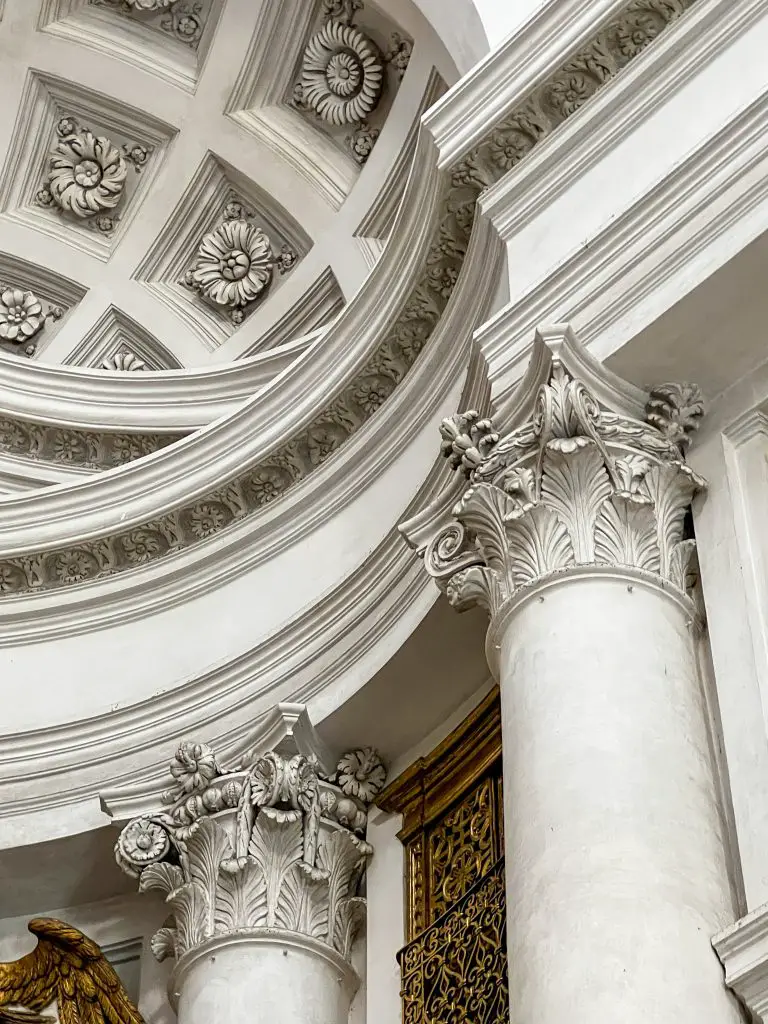
While it’s a baroque church, its structure is based on geometric figures. I love how the facade has an undulating effect which is repeated on the interior.
I love how crisp the interior white marble feels, even though it’s been standing there for centuries.
Don’t forget to check out the beautiful four fountains at the intersection nearby. Also at the intersection, you can see towards the Spanish Steps and towards St. Mary Major.
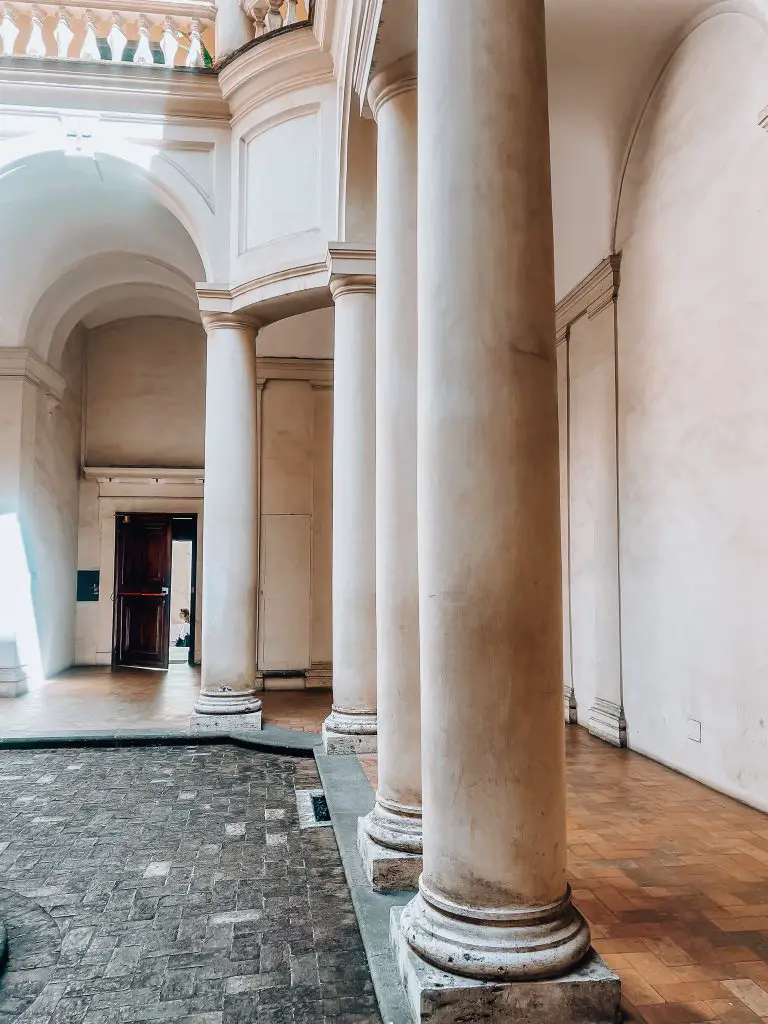
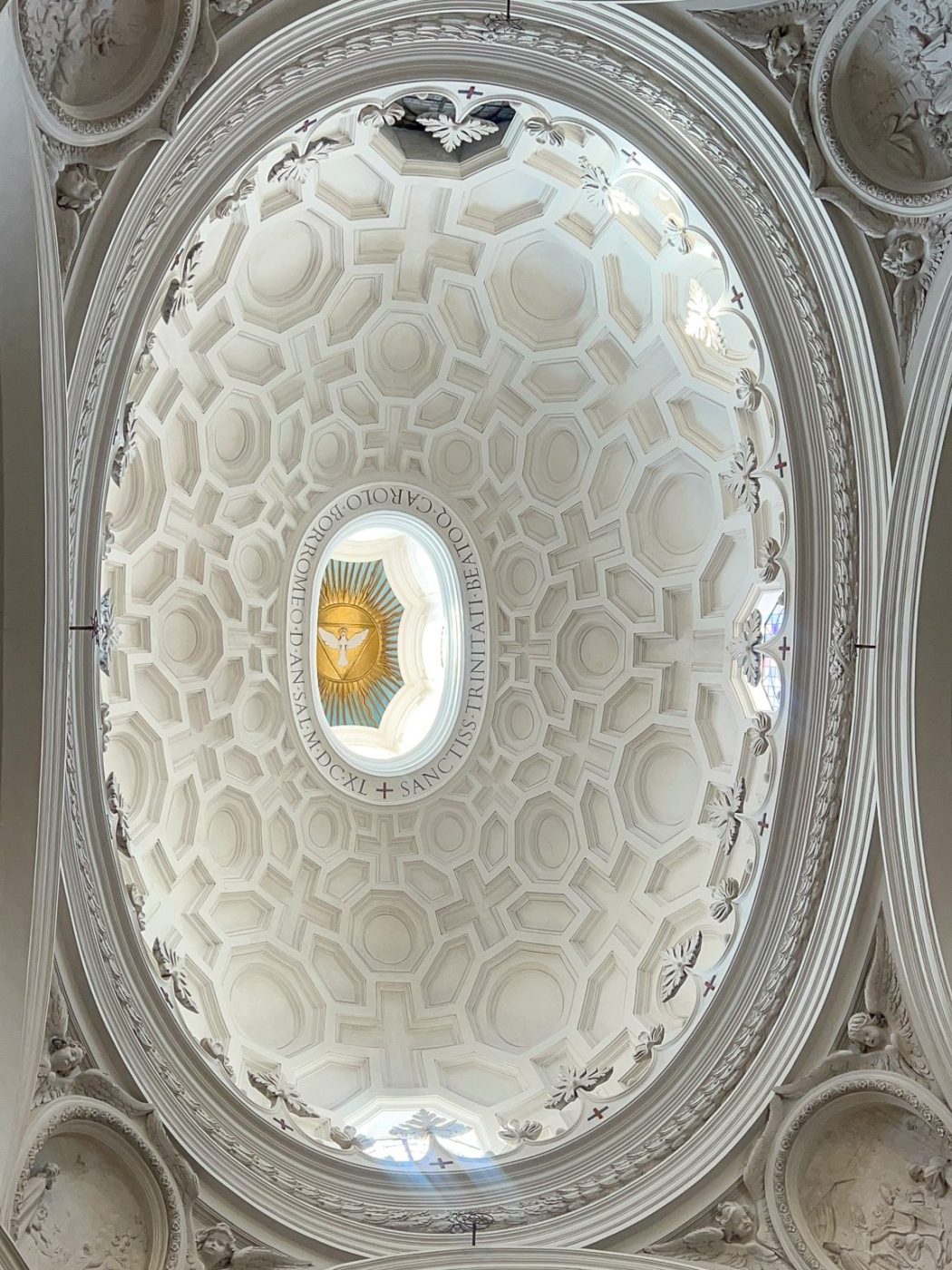
Church Sant’Andrea del Quirinale
Just down the road from The Church of San Carlo is the Church of Sant’ Andrea del Quirinale built by Bernini for the Jesuits.
Bernini considered it his only perfect work as he found a balance between sculpture, architecture, and painting.
The church is special for many reasons, but I found that with the entrance being along the long axis of the oval shape of the church, it creates a unique entry that I didn’t see in other churches.
Above the high altar is a painting of the Martyrdom of St. Andrew. Above that is a statue of St. Andrew ascending into heaven (the golden dome).
This church is often overlooked by tourists, but well worth a visit!

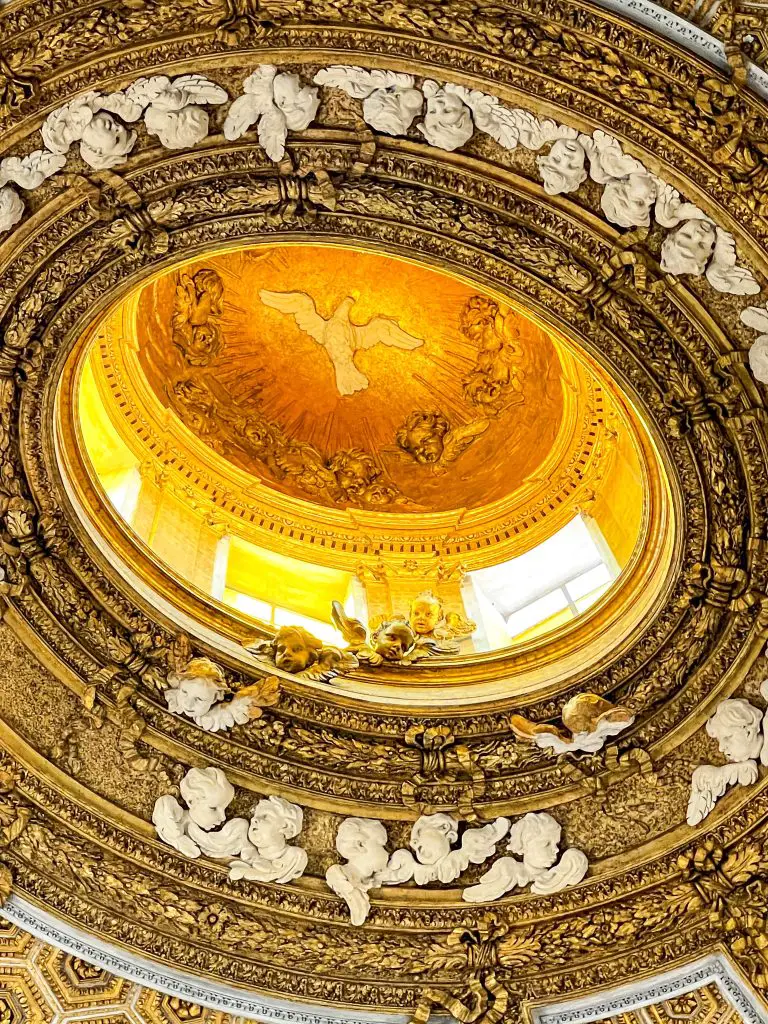
Church of San Luigi dei Francesi
Ready for more Caravaggio artwork? Head to the Church of St. Louis of the French to see three of his pieces depicting the life of St. Matthew: the Calling of St. Matthew, St. Matthew and the Angel, and the Martyrdom of St. Matthew.
You can see all three in the last chapel on the left of the church.

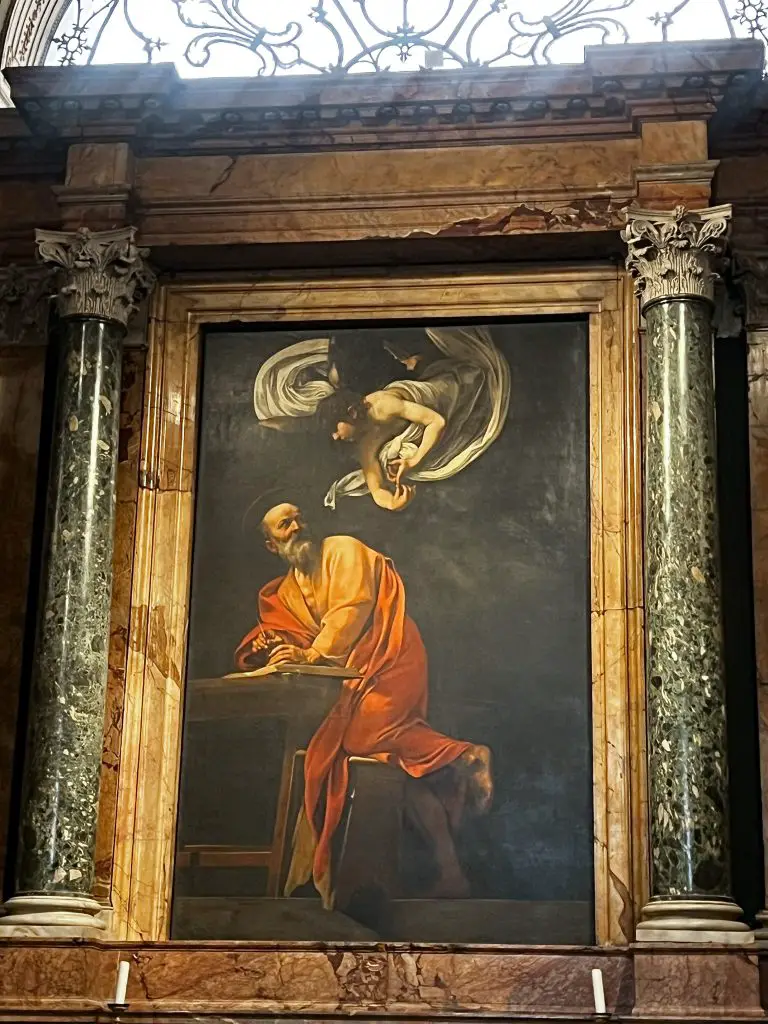

Santa Maria Vallicella
In Santa Maria Vallicella, you can see a copy of a Caravaggio piece called the Entombment of Christ, done by a Flemish artist. The original was stolen by Napoleon, but was recovered and is now in the Vatican Museums.
I found it interesting that copying was not seen as stealing; instead, it was what artists did back then. It was expected that new artists would paint copies of masterpieces.
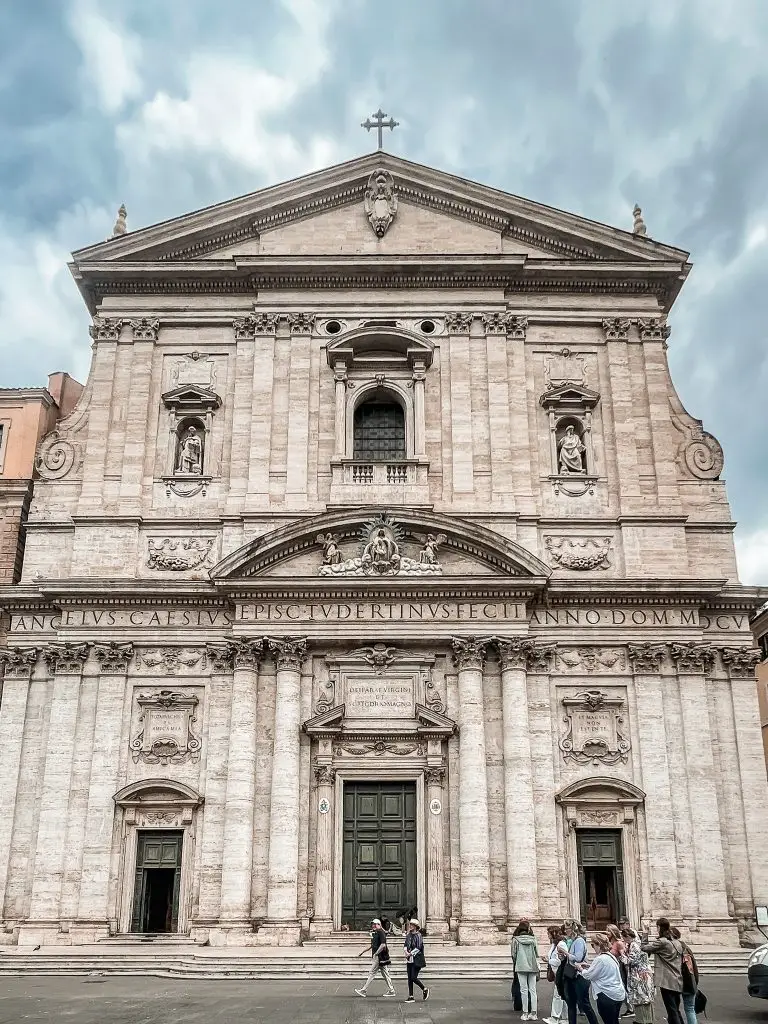

Chiesa del Gesù
Built in the 17th century, Chiesa del Gesù is the mother church of the Jesuit order and a beautiful example of Baroque architecture.
The church doesn’t have side aisles; instead, it has chapels dedicated to various saints, allowing for multiple services to be held simultaneously.
The tomb of Ignatius Loyola is at the center of the church. Supposedly, the painting hides a statue of St. Ignatius, which is revealed at 5:30 pm daily as the painting slides down to expose the statue!
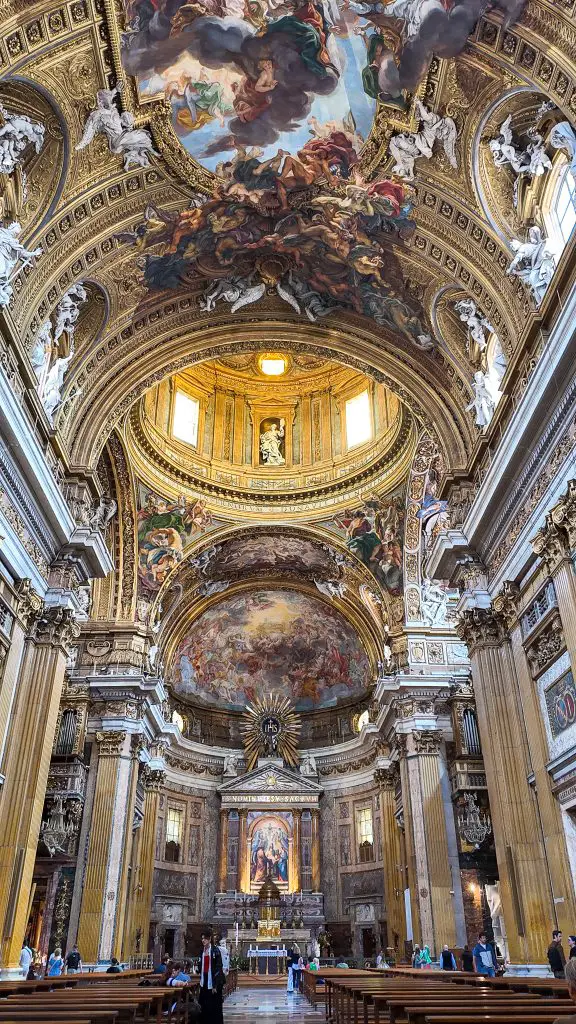
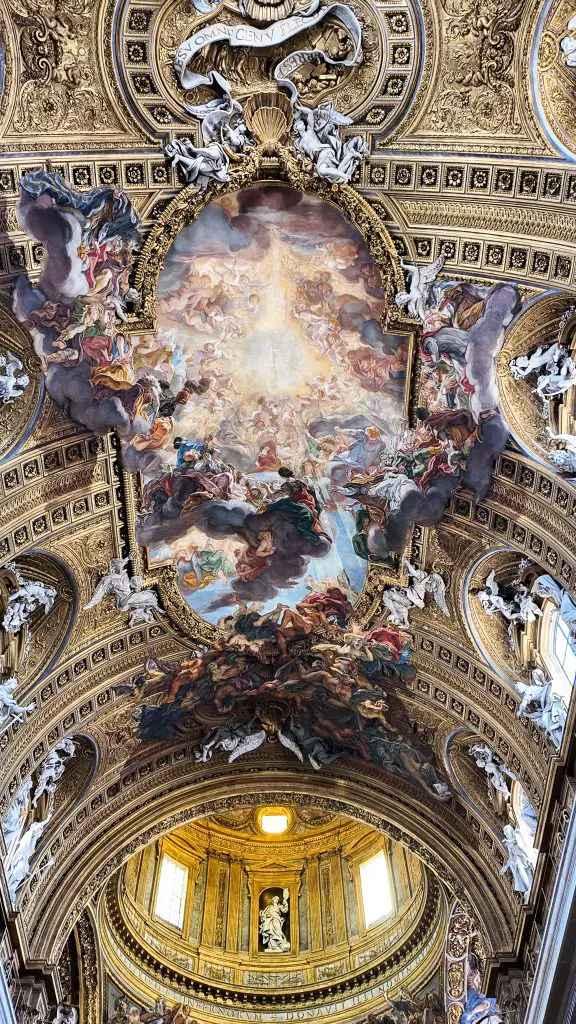
Wow! That was only 20 of the thousands of churches in Rome! There’s no need to enter all of them, but pick the ones that have things that interest you artistically or spiritually and add them to your Rome itinerary. If you can’t get to them all, that’s always a reason to go back to Rome!
Are there any churches I should add to my itinerary for my next trip?
Like this post? Pin for later!

